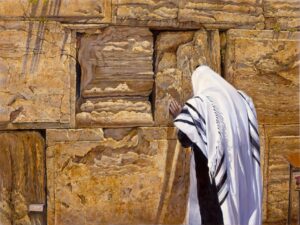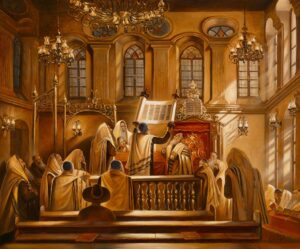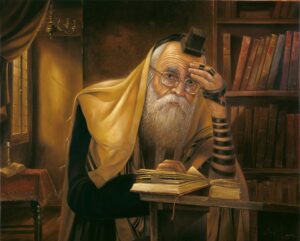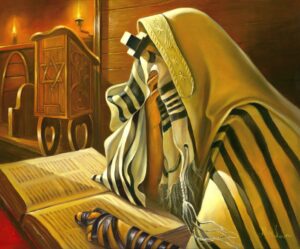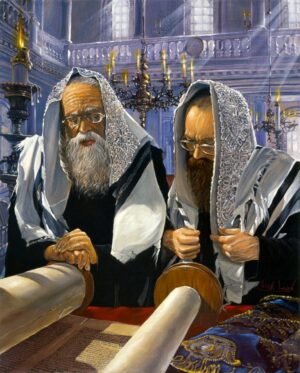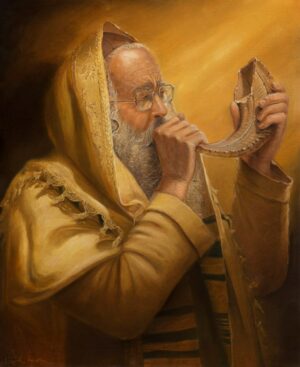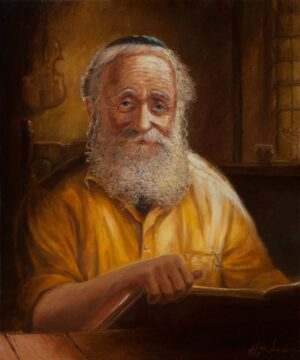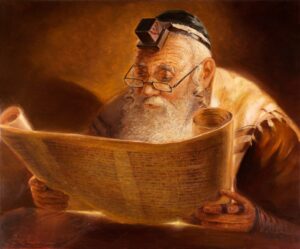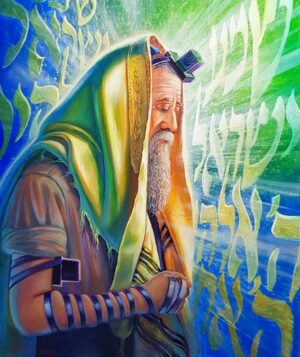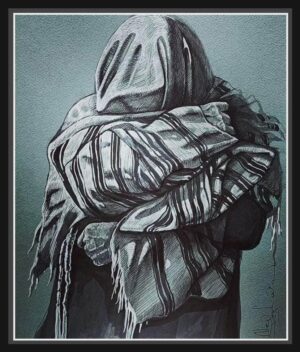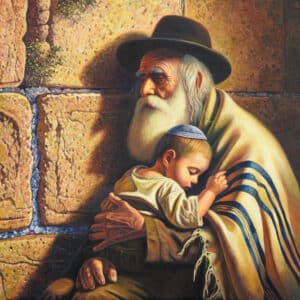Jewish Art, Judaica, Jerusalem Paintings
Jewish art is also popularly known as Judaica, which refers to an array of objects that are used by Jews for mainly ritual purposes. Literary arts are very connected to Judaica. Judaica is also famously produced a tradition of handicrafts and fine arts throughout the earlier Jewish history. In the first century, the Jewish community was found to be spread everywhere from Sardis to the Roman Empire, Ostia, Intercisa, and Hammam-Lif. There were additionally many prosperous Jewish communities in Asia Minor. While building their structures or monuments, the Jewish community often followed the Greco – Roman practice of decorating floors with mosaics. Jewish paintings have deep connections with the Biblical religion.
Judaism is a monotheistic religion that was practiced with the Israelites in the Eastern Mediterranean. During the Middle Ages, which was under Islamic rule, Jewish art was restricted to the illustration of manuscripts. The countries with stronger Muslim communities represented less physical representation of mostly human forms than in Northern European countries. There is another crucial factor that influenced the smaller scope of Jewish art. The Jewish people and Judaica fine art were very familiar with the Biblical stories.
The Start Of The Jewish Art
There are many popular Jewish artists of those times, which include illuminated manuscripts and illustrations of King David, Balaam, and Jonah. Additionally, there are illuminated Bibles from the same period of Yemen. But what is unique is that they do not contain the portrayal of human figures.
In western Europe, there was a more significant and higher acceptance of Jewish artists and Jews too. This meant they could practice their art more freely. The 19th and 20th centuries led to the rise of Jewish art and was much more accepted all over. Camille Pissarro was a painter who struggled to remain faithful to his style of painting. Modigliani was an Italian Jewish painter who had settled in Paris. He had a painting style that includes elongated faces that represent African masks.
Jewish artists work with the reality of time like Felix Nussbaum, who is known for this famous artwork “Self Portrait With Jewish Identity Card”. Jewish artists often move from one place to the other in search of inspiration for their amazing artworks. The center for Jewish Art has been sending graduate students and other groups of researchers on documentation programs and trips all over the world. The documentation teams primarily focused on sketching, photographing and detailing sites and structures of the Jewish art.
The significant events of World War 2 and the Holocaust had very long-lasting effects on Jewish art. ” White Crucifixion” is one of the attempts that deals with the devastation and pain of the Holocaust. Artists such as Ben Shahn and Leonard Baskin created works of art that depict the era. Among contemporary artists, there are numerous ways in which they may express their Jewish creativity. Over the years, the paintings and portraits have gained significance and immense popularity. The arts depict deep meanings and translations of the ancient times. Jewish art is still practiced heavily and is being taught as well.
Reproductions/Prints on Canvas and Metal
-
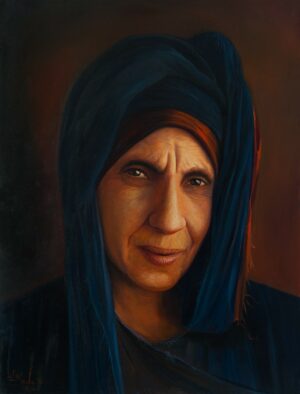
Nature Painting: Bedouin Woman
$195 – $1,220 This product has multiple variants. The options may be chosen on the product page -

Nature Painting: Beduins of Roshaida family
$195 – $1,160 This product has multiple variants. The options may be chosen on the product page -

Nature Painting: Life of Bedouins
$140 – $970 This product has multiple variants. The options may be chosen on the product page -

Nature Painting: Lonely Bedouin in Negev desert
$195 – $1,140 This product has multiple variants. The options may be chosen on the product page -

Nature Painting: Lonely grandmother
$195 – $1,140 This product has multiple variants. The options may be chosen on the product page -

Nature Painting: Man of the Desert
$195 – $1,280 This product has multiple variants. The options may be chosen on the product page -

Nature Painting: Sight by Bedouin of Judean Desert
$195 – $1,140 This product has multiple variants. The options may be chosen on the product page -

Nature Painting: Smile of bedouin girl
$195 – $1,220 This product has multiple variants. The options may be chosen on the product page -

Jewish Painting: Mea Shearim in Jerusalem
$195 – $915 This product has multiple variants. The options may be chosen on the product page -
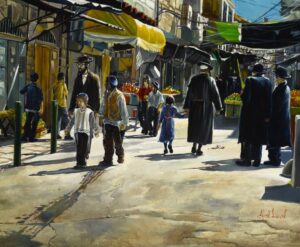
Jewish Painting: At the market of Mea Shearim in Jerusalem
$195 – $915 This product has multiple variants. The options may be chosen on the product page -

Nature Painting: Bedouin’s girl
$195 – $1,390 This product has multiple variants. The options may be chosen on the product page -
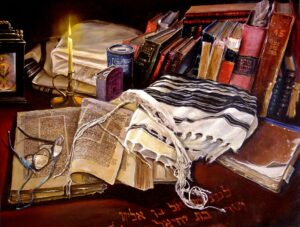
Jewish Painting: After the praying
$195 – $560 This product has multiple variants. The options may be chosen on the product page -

Jerusalem Painting: Praying on the Mount of Olives overlooking the Old City
$275 – $1,740 This product has multiple variants. The options may be chosen on the product page -

Jerusalem Painting: Jerusalem, the fragrance of prophets
$275 – $1,740 This product has multiple variants. The options may be chosen on the product page -

Jerusalem Painting: The first beams of the sun over the Holy Land
$275 – $595 This product has multiple variants. The options may be chosen on the product page -

Jewish Painting: Sounding the Shofar in Jerusalem
$235 – $1,740 This product has multiple variants. The options may be chosen on the product page -

Abstract Jerusalem Painting: Jerusalem of Gold
$195 – $1,130 This product has multiple variants. The options may be chosen on the product page -
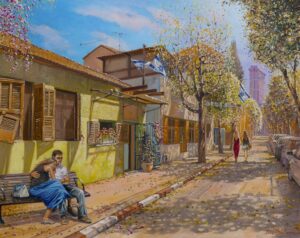
Tel Aviv Painting: Neve Tzedek, Tel Aviv
$195 – $1,160 This product has multiple variants. The options may be chosen on the product page -

Tel Aviv Painting: Cafe Bread Story in Tel Aviv
$275 – $1,080 This product has multiple variants. The options may be chosen on the product page -

Tel Aviv Painting: Colorful Bialik street in Tel Aviv
$275 – $1,300 This product has multiple variants. The options may be chosen on the product page -

Tel Aviv Painting: Rothschild street wears red
$195 – $1,230 This product has multiple variants. The options may be chosen on the product page -

Tel Aviv Painting: Shiny Happy people of Tel Aviv
$275 – $1,370 This product has multiple variants. The options may be chosen on the product page -

Tel Aviv Painting: Let’s fall in love on Rothschild street in Tel Aviv
$275 – $1,600 This product has multiple variants. The options may be chosen on the product page -

Tel Aviv Painting: Independence day in Nevei Zedek in Tel Aviv
$275 – $1,370 This product has multiple variants. The options may be chosen on the product page -

Tel Aviv Painting: Blossoming Rothschild Boulevard in Tel Aviv
$195 – $1,480 This product has multiple variants. The options may be chosen on the product page -

Tel Aviv Painting: Blissful rain is finally in Tel Aviv
$195 – $1,480 This product has multiple variants. The options may be chosen on the product page -

Tel Aviv Painting: Rain of light in Tel Aviv
$195 – $1,480 This product has multiple variants. The options may be chosen on the product page -

Tel Aviv Painting: Love under the sky of Tel Aviv
$195 – $1,260 This product has multiple variants. The options may be chosen on the product page -

Tel Aviv Painting: Stormy weather in old Jaffa
$275 – $1,370 This product has multiple variants. The options may be chosen on the product page -

Tel Aviv Painting: On Tel Aviv’s Rothschild Boulevard
$140 – $970 This product has multiple variants. The options may be chosen on the product page -

Tel Aviv Painting: Blue Rhapsody on Bialik street in Tel Aviv
$275 – $1,350 This product has multiple variants. The options may be chosen on the product page -
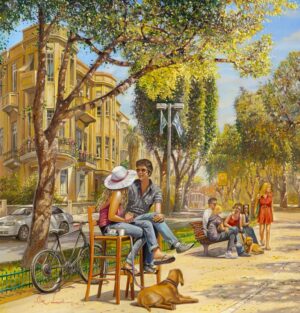
Tel Aviv Painting: On Tel Aviv’s Rothschild Boulevard
$140 – $970 This product has multiple variants. The options may be chosen on the product page -
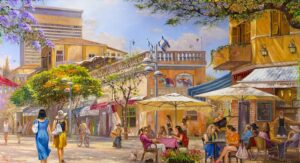
Tel Aviv Painting: Friday morning on Nahalat Benyamin in Tel Aviv
$275 – $1,350 This product has multiple variants. The options may be chosen on the product page -

Tel Aviv Painting: Let’s meet on Rothschild Boulevard in Tel Aviv
$195 – $1,610 This product has multiple variants. The options may be chosen on the product page -

Tel Aviv Painting: Coffee time on Rothschild street in Tel Aviv
$195 – $1,480 This product has multiple variants. The options may be chosen on the product page -

Tel Aviv Painting: Romantic cafe on Shenkin Street in Tel Aviv
$195 – $1,070 This product has multiple variants. The options may be chosen on the product page -

Tel Aviv Painting: Sunny beach of Tel Aviv
$275 – $1,370 This product has multiple variants. The options may be chosen on the product page -

Tel Aviv Painting: Shopping is always fun in Bezalel Market in Tel Aviv
$195 – $1,480 This product has multiple variants. The options may be chosen on the product page -

Tel Aviv Painting: Everybody Loves Rothschild Street in Tel Aviv
$235 – $1,480 This product has multiple variants. The options may be chosen on the product page -

Tel Aviv Painting: Fun time in Tel Aviv under the Sun
$275 – $1,370 This product has multiple variants. The options may be chosen on the product page -
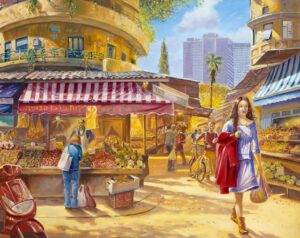
Tel Aviv Painting: Carmel Market in Tel Aviv
$195 – $915 This product has multiple variants. The options may be chosen on the product page -

Tel Aviv Painting: Lazy Morning on Rothschild’s Street in Tel Aviv
$195 – $1,070 This product has multiple variants. The options may be chosen on the product page -

Tel Aviv Painting: View on Tel Aviv thru the window
$195 – $1,160 This product has multiple variants. The options may be chosen on the product page -

Jaffa Painting: Enchanting old Jaffa
$195 – $1,130 This product has multiple variants. The options may be chosen on the product page -

Jaffa Painting: Family time in beautiful Jaffa
$275 – $1,200 This product has multiple variants. The options may be chosen on the product page -

Tel Aviv Painting: Having a good time in port of Tel Aviv
$275 – $1,120 This product has multiple variants. The options may be chosen on the product page -

Jaffa Painting: Jaffa port is waiting for you
$275 – $1,200 This product has multiple variants. The options may be chosen on the product page -

Tel Aviv Painting: Lazy summer days in Tel Aviv
$195 – $1,160 This product has multiple variants. The options may be chosen on the product page -

Jaffa Painting: Summer day in Jaffa
$195 – $1,070 This product has multiple variants. The options may be chosen on the product page -
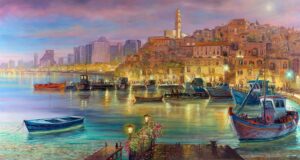
Jaffa Painting: There is a moon over Jaffa port tonight
$275 – $1,450 This product has multiple variants. The options may be chosen on the product page -
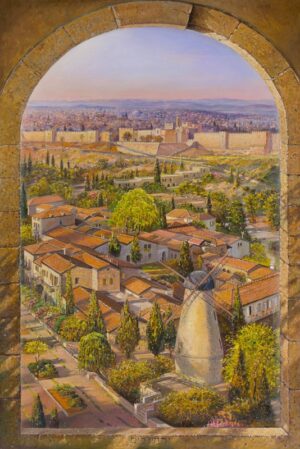
Jerusalem Painting: The beauty of Jerusalem Montefiore Windmill
$275 – $1,480 This product has multiple variants. The options may be chosen on the product page -

Jerusalem Painting: Jerusalem wears white
$235 – $1,610 This product has multiple variants. The options may be chosen on the product page -

Jerusalem Painting: Welcoming to a new day
$275 – $1,480 This product has multiple variants. The options may be chosen on the product page -
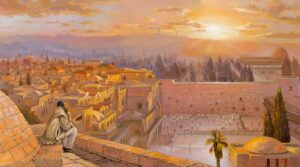
Jerusalem Painting: Welcoming the sunrise in Jerusalem
$235 – $1,740 This product has multiple variants. The options may be chosen on the product page -

Jerusalem Painting: Welcoming Messiah
$235 – $1,580 This product has multiple variants. The options may be chosen on the product page -

Jerusalem Painting: If I forget you, O Jerusalem, let my right hand forget her cunning
$235 – $1,580 This product has multiple variants. The options may be chosen on the product page -

Jerusalem Painting: The beauty of Jerusalem
$195 – $1,160 This product has multiple variants. The options may be chosen on the product page -

Jerusalem Painting: Light to the Nations
$235 – $1,390 This product has multiple variants. The options may be chosen on the product page -

Jerusalem Painting: Night at the Kotel in Jerusalem
$235 – $1,370 This product has multiple variants. The options may be chosen on the product page -

Jerusalem Painting: Birkat Kohanim
$235 – $1,490 This product has multiple variants. The options may be chosen on the product page -
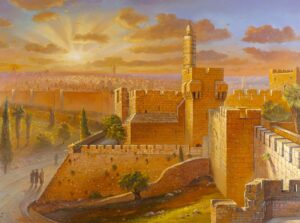
Jerusalem Painting: Migdal David morning Glow
$195 – $1,260 This product has multiple variants. The options may be chosen on the product page -

Jerusalem Painting: Birkat Kohanim in Jerusalem
$140 – $1,130 This product has multiple variants. The options may be chosen on the product page -

Jerusalem Painting: View from Jerusalem Roofs
$195 – $1,130 This product has multiple variants. The options may be chosen on the product page -
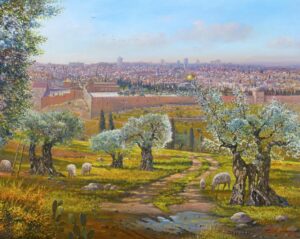
Jerusalem Painting: Holy Land
$195 – $1,220 This product has multiple variants. The options may be chosen on the product page -

Jerusalem Painting: The way to the Old Town of Jerusalem
$235 – $1,740 This product has multiple variants. The options may be chosen on the product page -

Jerusalem Painting: Morning of Yom Kippur in Jerusalem
$235 – $1,740 This product has multiple variants. The options may be chosen on the product page -

Jerusalem Painting: Mishkanot Shaananim
$275 – $1,740 This product has multiple variants. The options may be chosen on the product page -

Jerusalem Painting: Jerusalem at first Sight
$195 – $1,260 This product has multiple variants. The options may be chosen on the product page -

Jerusalem Painting: Jerusalem Market
$235 – $1,370 This product has multiple variants. The options may be chosen on the product page -

Jewish Painting: Chanukah lights and suvganiot
$195 – $915 This product has multiple variants. The options may be chosen on the product page -
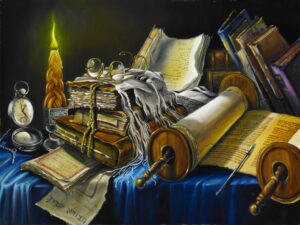
Jewish Painting: Still life with the open Torah
$195 – $1,220 This product has multiple variants. The options may be chosen on the product page -
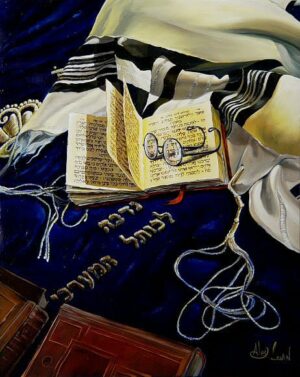
Jewish Painting: Still life with the book and glasses
$195 – $545 This product has multiple variants. The options may be chosen on the product page -

Jewish Painting: Still life with the Torah
$195 – $915 This product has multiple variants. The options may be chosen on the product page -

Jewish Painting: Still life with the hat and Torah
$195 – $1,160 This product has multiple variants. The options may be chosen on the product page -

Jewish Painting: Magic Light of Chanukah
$195 – $1,350 This product has multiple variants. The options may be chosen on the product page -
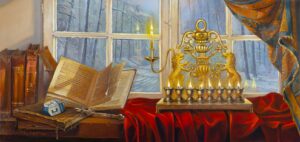
Jewish Painting: Hanukkah Lights
$275 – $1,740 This product has multiple variants. The options may be chosen on the product page -

Jewish Painting: First rain drops in Jerusalem
$195 – $915 This product has multiple variants. The options may be chosen on the product page -
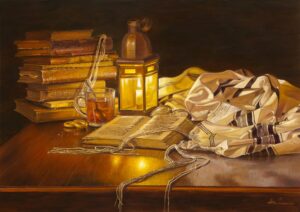
Jewish Painting: After the morning Prayer
$195 – $1,280 This product has multiple variants. The options may be chosen on the product page -

Jerusalem Painting: Road to Jerusalem
$195 – $1,320 This product has multiple variants. The options may be chosen on the product page -

Jerusalem Painting: Migdal David in Jerusalem
$195 – $1,160 This product has multiple variants. The options may be chosen on the product page -

Jerusalem Painting: Migdal David in Jerusalem
$195 – $1,220 This product has multiple variants. The options may be chosen on the product page -

Jerusalem Painting: Sunset in Jerusalem
$235 – $1,740 This product has multiple variants. The options may be chosen on the product page -
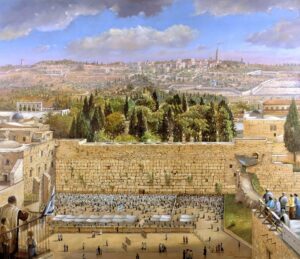
Jerusalem Painting: Birkat Kohanim in Jerusalem
$195 – $1,130 This product has multiple variants. The options may be chosen on the product page -

Jerusalem Painting: Old Market in Jerusalem
$235 – $830 This product has multiple variants. The options may be chosen on the product page -

Jerusalem Painting: Kotel
$195 – $1,110 This product has multiple variants. The options may be chosen on the product page -
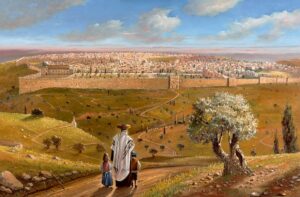
Jerusalem Painting: On the road to Jerusalem
$235 – $1,350 This product has multiple variants. The options may be chosen on the product page -
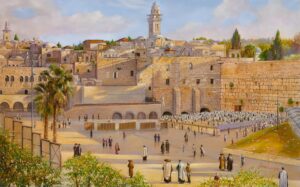
Jerusalem Painting: Morning by the Kotel in Jerusalem
$235 – $1,480 This product has multiple variants. The options may be chosen on the product page -

Jerusalem Painting: Light of Jerusalem
$235 – $1,330 This product has multiple variants. The options may be chosen on the product page -

Jerusalem Painting: Coming home
$235 – $1,350 This product has multiple variants. The options may be chosen on the product page -
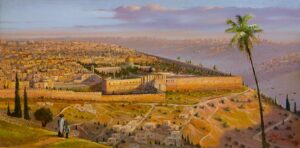
Jerusalem Painting: Morning rising above Jerusalem
$275 – $1,740 This product has multiple variants. The options may be chosen on the product page -

Jerusalem Painting: A night at the Kotel
$275 – $1,740 This product has multiple variants. The options may be chosen on the product page -
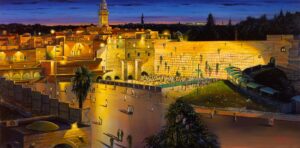
Jerusalem Painting: Rainy morning at the Kotel in Jerusalem
$275 – $1,740 This product has multiple variants. The options may be chosen on the product page -

Jerusalem Painting: Grandfather with the grandchildren on the road towards the old city
$235 – $1,740 This product has multiple variants. The options may be chosen on the product page -
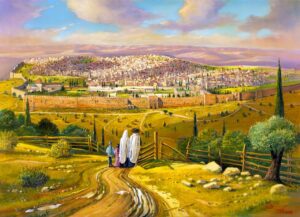
Jerusalem Painting: Road to Jerusalem
$195 – $1,370 This product has multiple variants. The options may be chosen on the product page -
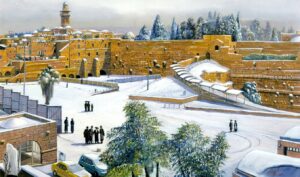
Jerusalem Painting: Snow by the Kotel in Jerusalem
$195 – $1,580 This product has multiple variants. The options may be chosen on the product page -

Jerusalem Painting: Snow by the Kotel in Jerusalem
$235 – $1,580 This product has multiple variants. The options may be chosen on the product page -

Jerusalem Painting: Taking the granddaughter back to school into Jerusalem after the Chanukah holidays
$275 – $1,580 This product has multiple variants. The options may be chosen on the product page -
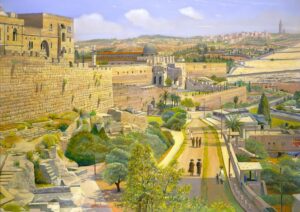
Jerusalem Painting: Afternoon wander round the Walls of Jerusalem
$195 – $1,260 This product has multiple variants. The options may be chosen on the product page -

Jerusalem Painting: Way to the Holy City. The dream came through
$195 – $1,100 This product has multiple variants. The options may be chosen on the product page -

Jerusalem Painting: Friday night by the Kotel in Jerusalem
$195 – $1,800 This product has multiple variants. The options may be chosen on the product page -

Jewish Painting: Journey to pray with Rachel – Rachels Tomb
$235 – $1,600 This product has multiple variants. The options may be chosen on the product page -
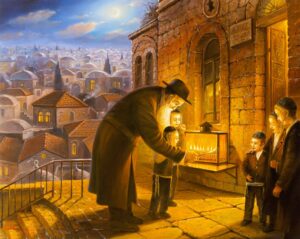
Jewish Painting: Hanukkah in Jerusalem
$195 – $1,160 This product has multiple variants. The options may be chosen on the product page -
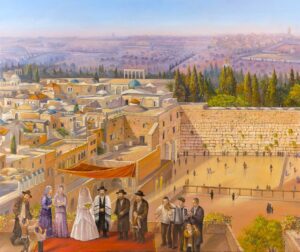
Jewish Painting: Chuppah on the roof by the Kotel in Jerusalem
$195 – $1,130 This product has multiple variants. The options may be chosen on the product page -

Jewish Painting: Last shopping before Shabbat in Jerusalem
$195 – $1,140 This product has multiple variants. The options may be chosen on the product page -
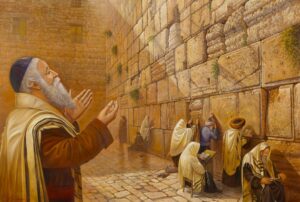
Jewish Painting: Power of Kotel
$235 – $1,350 This product has multiple variants. The options may be chosen on the product page -

Jewish Painting: To the Light
$195 – $1,220 This product has multiple variants. The options may be chosen on the product page -

Jewish Painting: Mincha at the Kotel in Jerusalem
$195 – $1,220 This product has multiple variants. The options may be chosen on the product page -

Jewish Painting: Birkat Kohanim in Jerusalem
$235 – $1,480 This product has multiple variants. The options may be chosen on the product page -
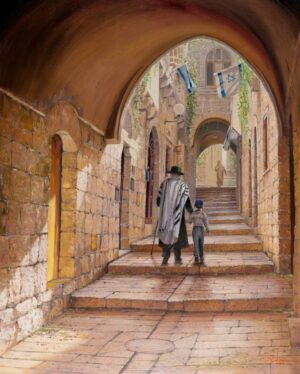
Jewish Painting: On the way Home
$195 – $1,160 This product has multiple variants. The options may be chosen on the product page -

Jewish Painting: Chuppah in Jerusalem
$195 – $1,130 This product has multiple variants. The options may be chosen on the product page -

Jewish Painting: Birkat Kohanim in Jerusalem
$195 – $1,280 This product has multiple variants. The options may be chosen on the product page -

Jewish Painting: Beit Knesset Hurva
$195 – $1,130 This product has multiple variants. The options may be chosen on the product page -

Jewish Painting: Chuppah in Jerusalem
$195 – $1,130 This product has multiple variants. The options may be chosen on the product page -

Jewish Painting: Praying by the Kotel in Jerusalem
$195 – $1,220 This product has multiple variants. The options may be chosen on the product page -

Jewish Painting: The day before the Sukkoth
$195 – $1,130 This product has multiple variants. The options may be chosen on the product page -

Jewish Painting: First wisdom lesson
$195 – $1,220 This product has multiple variants. The options may be chosen on the product page -
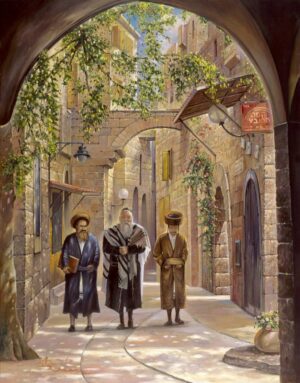
Jewish Painting: Three men walking in Jerusalem
$195 – $1,220 This product has multiple variants. The options may be chosen on the product page -

Jewish Painting: Silence of Tesha be Av near the Kotel in Jerusalem
$195 – $1,130 This product has multiple variants. The options may be chosen on the product page -

Jewish Painting: Sabbath at the Jewish Quarter in Jerusalem
$195 – $1,390 This product has multiple variants. The options may be chosen on the product page -

Jewish Painting: Street of Zfat
$195 – $1,100 This product has multiple variants. The options may be chosen on the product page -

Jewish Painting: Purim in Jerusalem
$195 – $1,220 This product has multiple variants. The options may be chosen on the product page -

Jewish Painting: Winter Sabbath in Williamsburg
$195 – $1,220 This product has multiple variants. The options may be chosen on the product page -

Jewish Painting: Purim at Mea Shearim in Jerusalem
$195 – $915 This product has multiple variants. The options may be chosen on the product page -

Jewish Painting: Enjoying the grandson
$195 – $915 This product has multiple variants. The options may be chosen on the product page -

Jewish Painting: New worker
$195 – $915 This product has multiple variants. The options may be chosen on the product page -
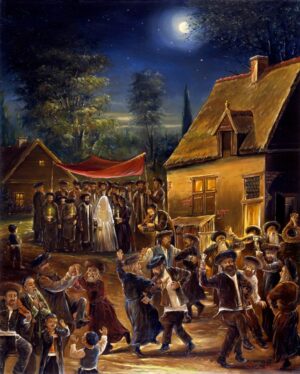
Jewish Painting: Chuppah Celebration in Shtetl
$195 – $915 This product has multiple variants. The options may be chosen on the product page -

Jewish Painting: Purim Celebration
$195 – $915 This product has multiple variants. The options may be chosen on the product page -

Jewish Painting: By the Kotel at Tesha be Av
$195 – $915 This product has multiple variants. The options may be chosen on the product page -

Jewish Painting: Magnificent light of Menorah
$195 – $915 This product has multiple variants. The options may be chosen on the product page -

Jewish Painting: Dancing with Torah at the Venice Synagogue
$195 – $1,220 This product has multiple variants. The options may be chosen on the product page -
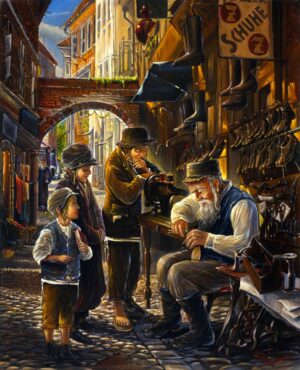
Jewish Painting: Shoemaker
$195 – $915 This product has multiple variants. The options may be chosen on the product page -

Jewish Painting: Torah Study in Shtetl
$195 – $915 This product has multiple variants. The options may be chosen on the product page -

Jewish Painting: Selecting the Willow, Myrtle and Etrog
$195 – $915 This product has multiple variants. The options may be chosen on the product page -

Jewish Painting: Wonderful Chanukah lights
$195 – $935 This product has multiple variants. The options may be chosen on the product page -

Jewish Painting: Torah Study in Shtetl
$195 – $915 This product has multiple variants. The options may be chosen on the product page -
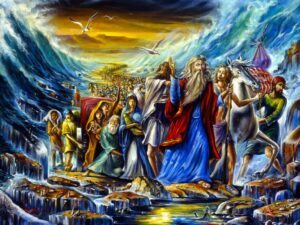
Jewish Painting: Moses leads the Exodus from the Egypt
$195 – $935 This product has multiple variants. The options may be chosen on the product page -

Jewish Painting: Tombs of the Patriarchs in Hebron (Maarat Hamachpela)
$195 – $1,180 This product has multiple variants. The options may be chosen on the product page -

Jewish Painting: Rachels Tomb – Kever Rachel
$195 – $1,160 This product has multiple variants. The options may be chosen on the product page -

Jewish Painting: Shabbat Shalom
$195 – $1,160 This product has multiple variants. The options may be chosen on the product page -
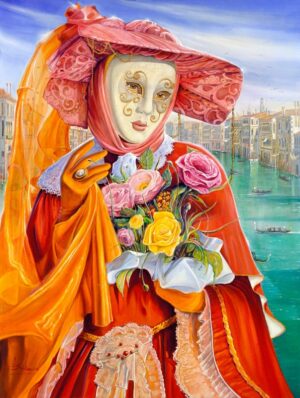
Venice Painting: Autumn Feelings
$195 – $1,220 This product has multiple variants. The options may be chosen on the product page -

Venice Painting: Colombina Red Velvet
$195 – $1,220 This product has multiple variants. The options may be chosen on the product page -

Venice Painting: Farewell Glance
$195 – $1,220 This product has multiple variants. The options may be chosen on the product page -

Venice Painting: Fortune Teller
$195 – $545 This product has multiple variants. The options may be chosen on the product page -
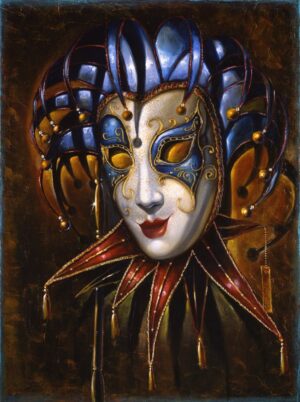
Venice Painting: Harmony
$195 – $1,220 This product has multiple variants. The options may be chosen on the product page -
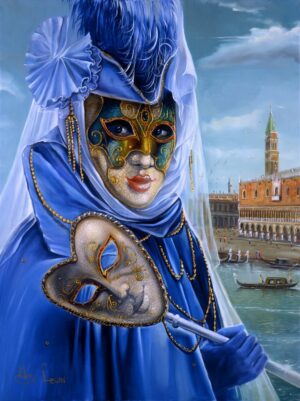
Venice Painting: Hidden truth beneath the mask
$195 – $1,220 This product has multiple variants. The options may be chosen on the product page -
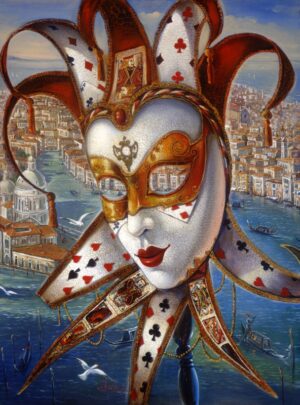
Venice Painting: Joker
$195 – $1,220 This product has multiple variants. The options may be chosen on the product page -
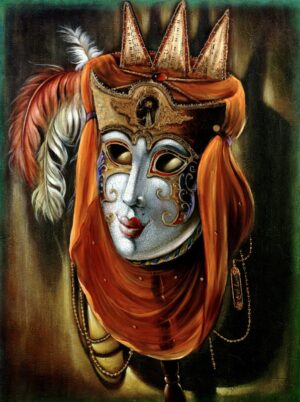
Venice Painting: Jolly Music Flute
$195 – $1,220 This product has multiple variants. The options may be chosen on the product page -
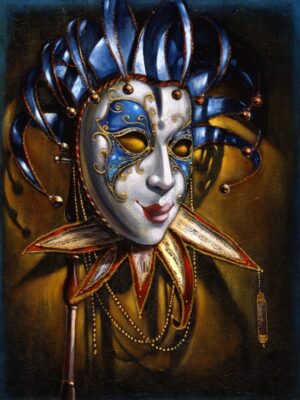
Venice Painting: Jolly Music Violin
$195 – $1,220 This product has multiple variants. The options may be chosen on the product page -
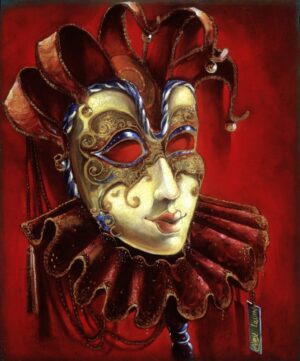
Venice Painting: Jolly Regina
$195 – $1,130 This product has multiple variants. The options may be chosen on the product page -
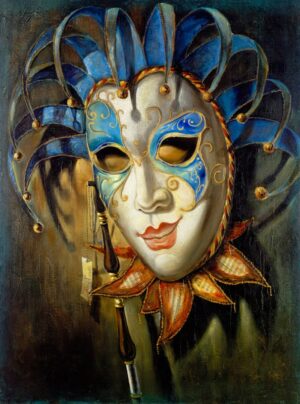
Venice Painting: Medusa Colombina Violin
$195 – $1,220 This product has multiple variants. The options may be chosen on the product page -
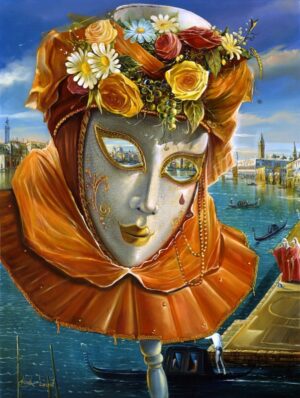
Venice Painting: Memories of Summer
$195 – $1,220 This product has multiple variants. The options may be chosen on the product page -

Venice Painting: Memories of Venice
$195 – $1,160 This product has multiple variants. The options may be chosen on the product page -

Venice Painting: Misty Winter in Venice
$195 – $1,220 This product has multiple variants. The options may be chosen on the product page -

Venice Painting: The Magical World of Fairies
$195 – $1,220 This product has multiple variants. The options may be chosen on the product page -

Venice Painting: Moonlight Serenade
$195 – $1,100 This product has multiple variants. The options may be chosen on the product page -
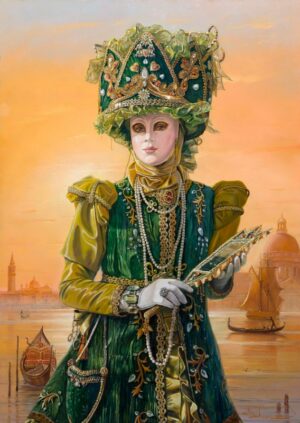
Venice Painting: Queen of Venice
$195 – $1,280 This product has multiple variants. The options may be chosen on the product page -

Venice Painting: Red Dream
$195 – $1,220 This product has multiple variants. The options may be chosen on the product page -

Venice Painting: Venetian Lady
$195 – $1,220 This product has multiple variants. The options may be chosen on the product page -

Venice Painting: Venetian mesmerizing gaze
$195 – $1,160 This product has multiple variants. The options may be chosen on the product page -

Venice Painting: Venetian Mystery
$195 – $1,280 This product has multiple variants. The options may be chosen on the product page -

Venice Painting: Venetian Trio
$195 – $1,160 This product has multiple variants. The options may be chosen on the product page -

Venice Painting: Venetian Trio
$195 – $1,160 This product has multiple variants. The options may be chosen on the product page -
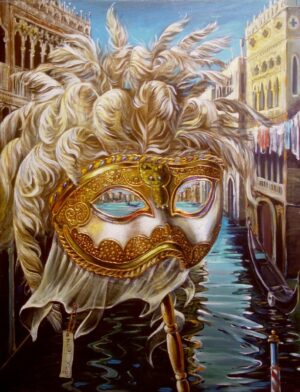
Venice Painting: Venetian Zephyr
$195 – $1,200 This product has multiple variants. The options may be chosen on the product page -
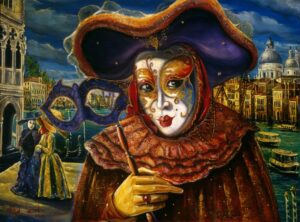
Venice Painting: Carnival Echo
$195 – $1,220 This product has multiple variants. The options may be chosen on the product page -

Venice Painting: Do not long for me, I will return
$195 – $1,220 This product has multiple variants. The options may be chosen on the product page -

Venice Painting: Memories of Casanova
$195 – $1,130 This product has multiple variants. The options may be chosen on the product page -

Venice Painting: Musing of azure mask
$195 – $1,220 This product has multiple variants. The options may be chosen on the product page -

Venice Painting: Time to smell the roses
$275 – $1,820 This product has multiple variants. The options may be chosen on the product page -
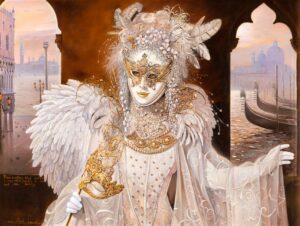
Venice Painting: Venetian Angel
$195 – $1,220 This product has multiple variants. The options may be chosen on the product page -

Jerusalem Painting: Peaceful life in Jerusalem
$195 – $1,220 This product has multiple variants. The options may be chosen on the product page -

Jerusalem Painting: Old streets of Jerusalem
$195 – $1,220 This product has multiple variants. The options may be chosen on the product page -

Jewish Painting: Cheider in Shtetl
$195 – $1,160 This product has multiple variants. The options may be chosen on the product page -
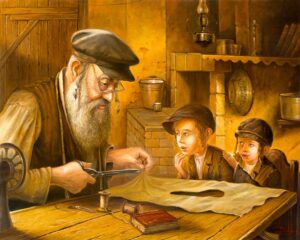
Jewish Painting: The Tailor in Shtetl
$195 – $1,160 This product has multiple variants. The options may be chosen on the product page -
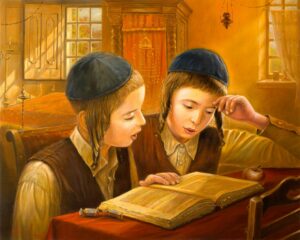
Jewish Painting: Boys Time
$195 – $1,160 This product has multiple variants. The options may be chosen on the product page -
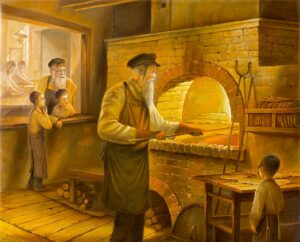
Jewish Painting: Making Matzah
$195 – $1,160 This product has multiple variants. The options may be chosen on the product page -
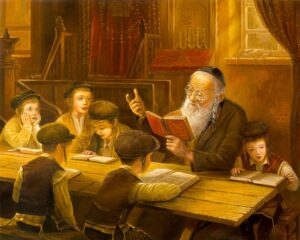
Jewish Painting: Cheider in Shtetl
$195 – $1,160 This product has multiple variants. The options may be chosen on the product page -
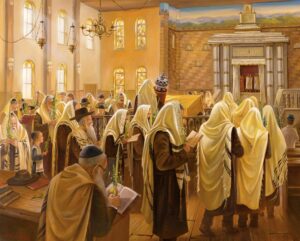
Jewish Painting: Sukkot in Kfar Chabad Synagogue
$195 – $1,220 This product has multiple variants. The options may be chosen on the product page -

Jewish Painting: Night of Tisha be Av
$195 – $1,160 This product has multiple variants. The options may be chosen on the product page -

Jerusalem Painting: Sunny day in Old Jerusalem
$195 – $1,160 This product has multiple variants. The options may be chosen on the product page -
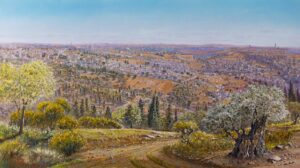
Jerusalem Painting: The promised land of Israel
$235 – $1,570 This product has multiple variants. The options may be chosen on the product page -
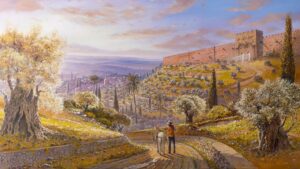
Jerusalem Painting: The Golden Gate in Jerusalem
$235 – $1,570 This product has multiple variants. The options may be chosen on the product page -

Jerusalem Painting: Old Jerusalem behind the olive tree
$235 – $1,370 This product has multiple variants. The options may be chosen on the product page -
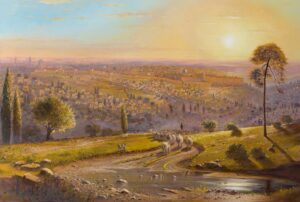
Jerusalem Painting: Jerusalem, The Light of the World
$195 – $1,350 This product has multiple variants. The options may be chosen on the product page -

Jerusalem Painting: Migdal David in Jerusalem
$235 – $1,570 This product has multiple variants. The options may be chosen on the product page -

Jerusalem Painting: Over the hills, Peace and glory
$235 – $1,390 This product has multiple variants. The options may be chosen on the product page -

Jerusalem Painting: My Dream
$195 – $1,220 This product has multiple variants. The options may be chosen on the product page -

Jewish Painting: Silence of Tesha be Av near the Kotel
$140 – $1,130 This product has multiple variants. The options may be chosen on the product page -
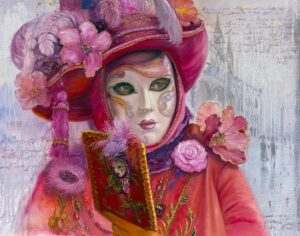
Venice Painting: Vivaldi’s Muse
$195 – $1,160 This product has multiple variants. The options may be chosen on the product page -

Venice Painting: Venetian Breeze
$195 – $1,220 This product has multiple variants. The options may be chosen on the product page -

Tel Aviv Painting: Breakfast in Tel Aviv’s Caf?
$195 – $1,220 This product has multiple variants. The options may be chosen on the product page -

Tel Aviv Painting: Park HaYakron, Tel Aviv
$275 – $1,740 This product has multiple variants. The options may be chosen on the product page -

Tel Aviv Painting: Israel – Past, Present and Future
$195 – $1,070 This product has multiple variants. The options may be chosen on the product page -
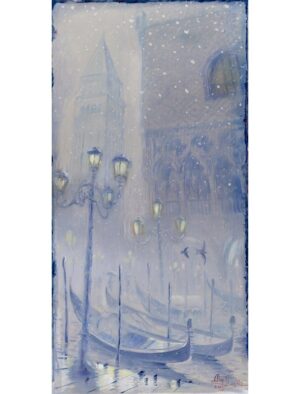
Painting: Chopin – Piano Concerto 1 and 2
$275 – $750 This product has multiple variants. The options may be chosen on the product page -

Painting: Tchaikovsky – Symphony No. 6
$275 – $750 This product has multiple variants. The options may be chosen on the product page -

Painting: Vivaldi – Winter
$275 – $750 This product has multiple variants. The options may be chosen on the product page -

Painting: Beethoven – Moonlight Sonata
$275 – $750 This product has multiple variants. The options may be chosen on the product page -

Painting: Handel – Concerti Grossi No. 1-12
$275 – $750 This product has multiple variants. The options may be chosen on the product page -

Painting: Chopin – Piano Concerto No.2
$195 – $850 This product has multiple variants. The options may be chosen on the product page -
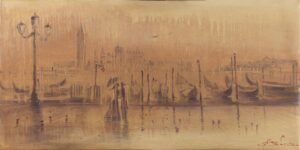
Painting: Dvorak – Romance for piano and violin
$275 – $750 This product has multiple variants. The options may be chosen on the product page -

Painting: Mozart – Piano Concerto No. 9
$275 – $750 This product has multiple variants. The options may be chosen on the product page -

Painting: Vivaldi – Spring
$275 – $750 This product has multiple variants. The options may be chosen on the product page -

Painting: Chopin – Nocturne No. 20
$275 – $750 This product has multiple variants. The options may be chosen on the product page -
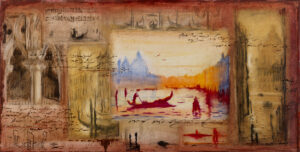
Painting: Vivaldi – 12 Sonatas for violin
$275 – $750 This product has multiple variants. The options may be chosen on the product page -

Painting: Mozart – Piano Concerto No. 25
$275 – $750 This product has multiple variants. The options may be chosen on the product page -

Painting: Debussy – La Mer
$275 – $750 This product has multiple variants. The options may be chosen on the product page -

Painting: Paganini – Concerto per Violino Orchestra No.1
$275 – $750 This product has multiple variants. The options may be chosen on the product page -

Painting: Mendelssohn – Violin Concerto E Minor
$275 – $750 This product has multiple variants. The options may be chosen on the product page -

Painting: Gershwin – Rhapsody In Blue
$275 – $750 This product has multiple variants. The options may be chosen on the product page -

Painting: Vivaldi – Concerto for two mandolins in G major
$195 – $750 This product has multiple variants. The options may be chosen on the product page -

Painting: Brahms – Symphony No.3 – Poco Allegretto
$275 – $750 This product has multiple variants. The options may be chosen on the product page -
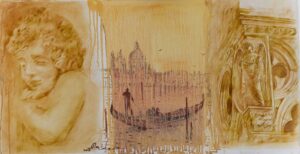
Painting: Gluck – Melodie from Orfeo and Euridica
$275 – $750 This product has multiple variants. The options may be chosen on the product page -

Painting: Mozart – Piano Concerto No. 12
$275 – $750 This product has multiple variants. The options may be chosen on the product page -

Painting: Bach – Concerto for Violin and Orchestra in D minor
$275 – $750 This product has multiple variants. The options may be chosen on the product page -
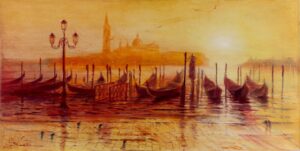
Painting: Bach – Toccata and Fugue in D minor
$275 – $750 This product has multiple variants. The options may be chosen on the product page -
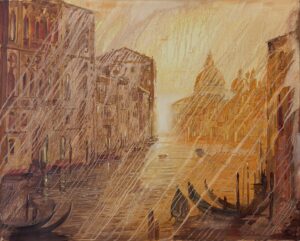
Painting: Mozart – Piano Concerto No. 20
$195 – $915 This product has multiple variants. The options may be chosen on the product page -
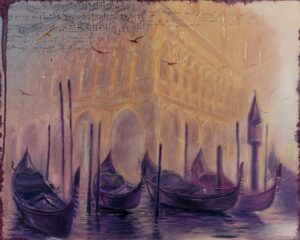
Painting: Grieg – Peer Gynt Suite No. 1
$195 – $915 This product has multiple variants. The options may be chosen on the product page -
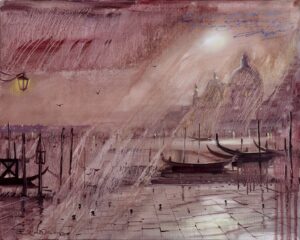
Painting: Beethoven – Symphony No. 5
$195 – $915 This product has multiple variants. The options may be chosen on the product page -
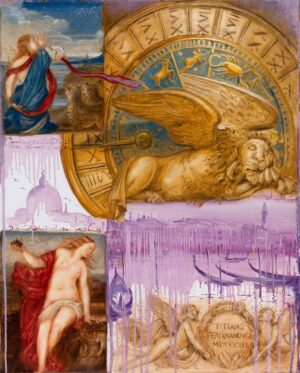
Painting: Vivaldi – Four Seasons
$195 – $915 This product has multiple variants. The options may be chosen on the product page -

Painting: Bach – St Matthew Passion
$195 – $1,160 This product has multiple variants. The options may be chosen on the product page -

Painting: Schubert – Serenade
$195 – $915 This product has multiple variants. The options may be chosen on the product page -

Painting: Chopin – Nocturne No. 2
$195 – $915 This product has multiple variants. The options may be chosen on the product page -
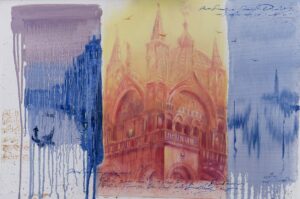
Painting: Vivaldi – The Four Seasons, Winter
$195 – $850 This product has multiple variants. The options may be chosen on the product page -

Painting: Vivaldi – The Four Seasons, Autumn
$195 – $850 This product has multiple variants. The options may be chosen on the product page -

Painting: Vivaldi – Concerti della Natura
$195 – $850 This product has multiple variants. The options may be chosen on the product page -
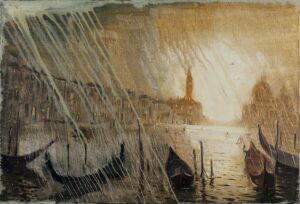
Painting: Beethoven – Symphony No. 3
$195 – $850 This product has multiple variants. The options may be chosen on the product page -
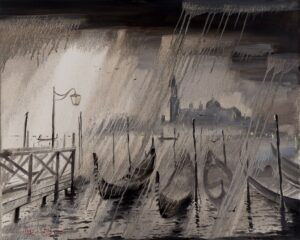
Painting: Wagner – La cabalgata de las Valkirias
$195 – $850 This product has multiple variants. The options may be chosen on the product page -

Painting: Grieg – Piano Concerto in A minor
$195 – $850 This product has multiple variants. The options may be chosen on the product page -

Painting: Bach – Overture No. 3 in D Major “Air”
$195 – $850 This product has multiple variants. The options may be chosen on the product page -

Painting: Rachmaninov – Elegie in E flat minor
$195 – $710 This product has multiple variants. The options may be chosen on the product page -

Painting: Gershwin – Rhapsody In Blue
$275 – $845 This product has multiple variants. The options may be chosen on the product page -

Painting: Schubert – Ave Maria
$275 – $845 This product has multiple variants. The options may be chosen on the product page -

Jerusalem Painting: Jerusalem of Gold
$195 – $915 This product has multiple variants. The options may be chosen on the product page -

Jerusalem Painting: Birds Eye View of Jerusalem
$195 – $710 This product has multiple variants. The options may be chosen on the product page -

Jerusalem Painting: Old Market in Jerusalem
$195 – $1,160 This product has multiple variants. The options may be chosen on the product page -

Nature Painting: Lilies
$275 – $1,370 This product has multiple variants. The options may be chosen on the product page -
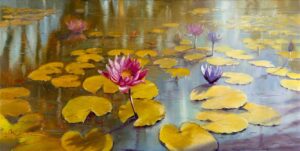
Nature Painting: Lilies
$275 – $1,370 This product has multiple variants. The options may be chosen on the product page -

Tel Aviv Painting: Nahalat Binyamin in Tel Aviv
$235 – $1,370 This product has multiple variants. The options may be chosen on the product page -

Tel Aviv Painting: Birds Eye View of Tel Aviv
$195 – $1,160 This product has multiple variants. The options may be chosen on the product page -

Jerusalem Painting: Street in the old City of Jerusalem
$195 – $1,160 This product has multiple variants. The options may be chosen on the product page -

Jewish Painting: Abraham and his son Isaac
$195 – $1,130 This product has multiple variants. The options may be chosen on the product page -

Jewish Painting: Foremother Rachel
$195 – $1,160 This product has multiple variants. The options may be chosen on the product page -

Jewish Painting: King David, Journey ahead
$195 – $1,130 This product has multiple variants. The options may be chosen on the product page -

Jewish Painting: King Solomon
$195 – $1,130 This product has multiple variants. The options may be chosen on the product page -
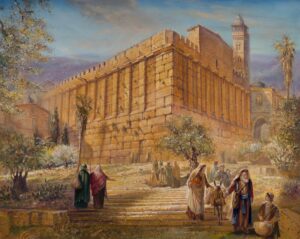
Jewish Painting: Maarat Hamachpela in Hebron
$195 – $1,160 This product has multiple variants. The options may be chosen on the product page -
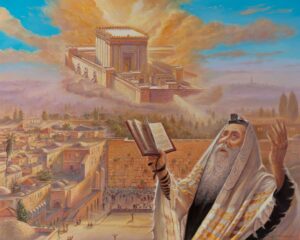
Jerusalem Painting: Our prayers have been answered
$195 – $1,160 This product has multiple variants. The options may be chosen on the product page -

Jewish Painting: A Bible love story between Jacob and Rachel
$195 – $1,130 This product has multiple variants. The options may be chosen on the product page -

Jewish Painting: The Exodus and the Babylonian Exile of Israel
$235 – $1,350 This product has multiple variants. The options may be chosen on the product page -
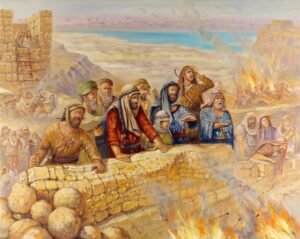
Jewish Painting: Last hours of brave Zealots on Masada
$195 – $1,160 This product has multiple variants. The options may be chosen on the product page -

Nature Painting: Lilies
$195 – $1,130 This product has multiple variants. The options may be chosen on the product page -
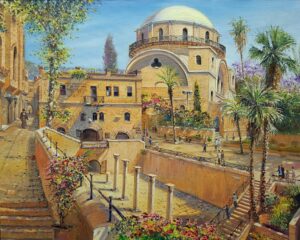
Jerusalem Painting: Steps to Zion
$195 – $1,160 This product has multiple variants. The options may be chosen on the product page -
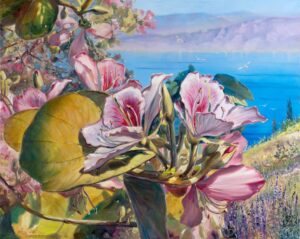
Nature Painting: Azure riviera of Biblical Kineret
$195 – $1,160 This product has multiple variants. The options may be chosen on the product page -

Jerusalem Painting: View on the Golden Gate from the Garden of Gethsemane
$195 – $1,320 This product has multiple variants. The options may be chosen on the product page -

Nature Painting: Poppies on the Biblical Land
$195 – $1,320 This product has multiple variants. The options may be chosen on the product page -

Nature Painting: Biblical Garden
$195 – $1,060 This product has multiple variants. The options may be chosen on the product page -

Nature Painting: Autumn leaves
$195 – $850 This product has multiple variants. The options may be chosen on the product page -

Nature Painting: View on Kineret from the Golan Heights
$195 – $1,160 This product has multiple variants. The options may be chosen on the product page -

Nature Painting: Israel – The Land of creation
$195 – $1,130 This product has multiple variants. The options may be chosen on the product page -

Nature Painting: Divine Nature
$195 – $1,350 This product has multiple variants. The options may be chosen on the product page -

Nature Painting: Land of promise
$195 – $1,740 This product has multiple variants. The options may be chosen on the product page -

Jerusalem Painting: The court yard in the Nachlaot neighborhood of Jerusalem
$195 – $1,030 This product has multiple variants. The options may be chosen on the product page -

Jerusalem Painting: Morning on the Mount Zion in Jerusalem
$195 – $1,130 This product has multiple variants. The options may be chosen on the product page -

Nature Painting: Israel – the Land of light and sun
$195 – $1,740 This product has multiple variants. The options may be chosen on the product page -

Nature Painting: The Land of creation
$195 – $1,130 This product has multiple variants. The options may be chosen on the product page -

Tel Aviv Painting: Rothschild Boulevard in Tel Aviv
$275 – $1,260 This product has multiple variants. The options may be chosen on the product page -

Venice Painting: Miss Venetta
$195 – $1,480 This product has multiple variants. The options may be chosen on the product page -

Jerusalem Temple Painting: Second Jewish Temple in Jerusalem
$195 – $1,130 This product has multiple variants. The options may be chosen on the product page -

Nature Painting: Poppies on the Biblical Land
$195 – $1,350 This product has multiple variants. The options may be chosen on the product page -
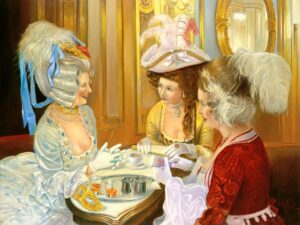
Venice Painting: Carnival stories in Caffe Florian
$195 – $1,220 This product has multiple variants. The options may be chosen on the product page -
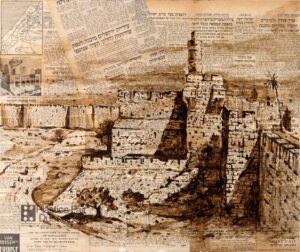
Israeli Painting: Reunification of Jerusalem after the Six-Day War
$195 – $1,130 This product has multiple variants. The options may be chosen on the product page -

Tel Aviv Painting: One Day in Tel Aviv
$195 – $1,070 This product has multiple variants. The options may be chosen on the product page -

Nature Painting: Lilies
$195 – $1,740 This product has multiple variants. The options may be chosen on the product page -

Jerusalem Painting: Overlooking Migdal David in Jerusalem
$235 – $1,110 This product has multiple variants. The options may be chosen on the product page -

Jewish Painting: Challah with tea
$195 – $1,130 This product has multiple variants. The options may be chosen on the product page -

Jewish Painting: After the morning Prayer in Shtetl
$235 – $1,350 This product has multiple variants. The options may be chosen on the product page -

Israeli Painting: Memories from the six day Israeli war, 1967
$195 – $1,740 This product has multiple variants. The options may be chosen on the product page -
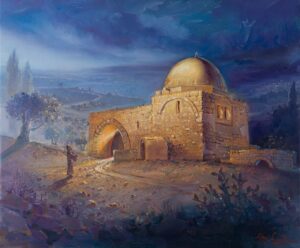
Jewish Painting: Kever Rachel – Rachel’s Tomb
$195 – $870 This product has multiple variants. The options may be chosen on the product page -
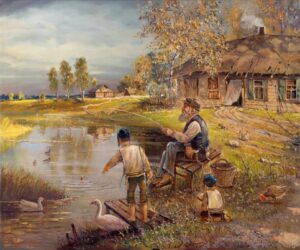
Jewish Painting: Life in Shtetl
$195 – $1,130 This product has multiple variants. The options may be chosen on the product page -
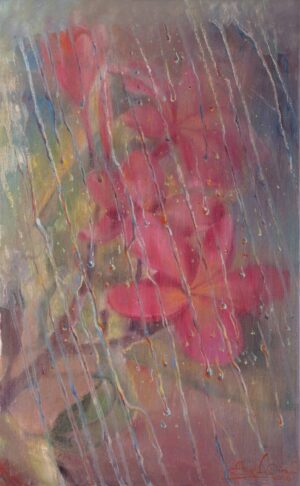
Nature Painting: Rainy improvisation
$195 – $1,080 This product has multiple variants. The options may be chosen on the product page -

Venice Painting: Dreams are my reality
$195 – $1,280 This product has multiple variants. The options may be chosen on the product page -

Tel Aviv Painting: Enjoying life in Tel Aviv
$195 – $995 This product has multiple variants. The options may be chosen on the product page -

Tel Aviv Painting: Light of Tel Aviv
$195 – $995 This product has multiple variants. The options may be chosen on the product page -

Tel Aviv Painting: Tel Aviv always loves peace
$195 – $995 This product has multiple variants. The options may be chosen on the product page -
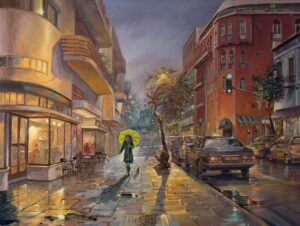
Tel Aviv Painting: Tel Aviv listens to Miles Davis
$195 – $995 This product has multiple variants. The options may be chosen on the product page -

Jerusalem Painting: Synagogue Hurva at Night in Jerusalem
$195 – $1,160 This product has multiple variants. The options may be chosen on the product page -
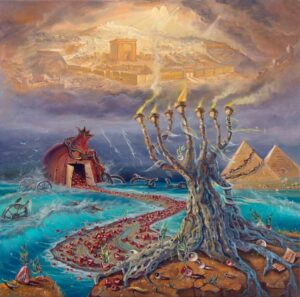
Jewish Surrealism Painting: Exodus
$95 – $970 This product has multiple variants. The options may be chosen on the product page -

Israeli Painting: Flag of Israel on the Temple Mount
$275 – $795 This product has multiple variants. The options may be chosen on the product page -

Jewish Surrealism Painting: Steps of time, The Dead Sea Scrolls
$95 – $970 This product has multiple variants. The options may be chosen on the product page -

Surrealism Painting: Nir permanent sub Sole – Nothing is eternal under the sun
$140 – $970 This product has multiple variants. The options may be chosen on the product page -

Jewish Surrealism Painting: Neilah – Closing of the gates
$140 – $970 This product has multiple variants. The options may be chosen on the product page -

Surrealism Painting: Vita Brevis Ars Longa – Art is long Life is short
$140 – $970 This product has multiple variants. The options may be chosen on the product page -
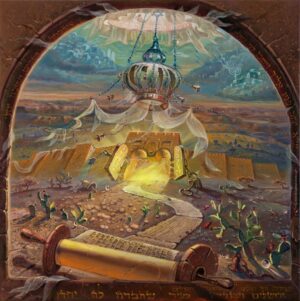
Jewish Surrealism Painting: The coming of the Messiah
$95 – $970 This product has multiple variants. The options may be chosen on the product page -

Nature Painting: The Garden of Eden
$95 – $970 This product has multiple variants. The options may be chosen on the product page -
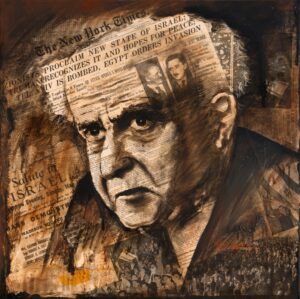
Israeli Painting: Zionists Proclaim New State of Israel
$95 – $970 This product has multiple variants. The options may be chosen on the product page -

Israeli Painting: Memories of the war of Yom Kippur 1973
$215 – $1,130 This product has multiple variants. The options may be chosen on the product page -

Israeli Painting: Israel’s War of Independence
$215 – $1,130 This product has multiple variants. The options may be chosen on the product page -

Israeli Painting: The Victory of 1967
$235 – $1,160 This product has multiple variants. The options may be chosen on the product page -

Israeli Painting: Year 1973 – The day of Yom Kipur
$215 – $1,130 This product has multiple variants. The options may be chosen on the product page -

Israeli Painting: Herzl’s Dream
$275 – $995 This product has multiple variants. The options may be chosen on the product page -

Israeli Painting: The battle for the Golan Heights
$195 – $1,200 This product has multiple variants. The options may be chosen on the product page -

Israeli Painting: Paratroopers of 1967 and 2017
$195 – $1,130 This product has multiple variants. The options may be chosen on the product page -

Israeli Painting: Tzanhanim by the Kotel – 1967
$195 – $1,350 This product has multiple variants. The options may be chosen on the product page -

Israeli Painting: Praying by the Kotel
$195 – $1,350 This product has multiple variants. The options may be chosen on the product page -

Israeli Painting: Power of Praying
$275 – $1,080 This product has multiple variants. The options may be chosen on the product page -

Israeli Painting: Power of Praying with Torah
$275 – $1,740 This product has multiple variants. The options may be chosen on the product page -

Israeli Painting: The state of Israel is born
$275 – $1,260 This product has multiple variants. The options may be chosen on the product page -

Israeli Painting: First days after the Independence Day of Israel
$195 – $1,130 This product has multiple variants. The options may be chosen on the product page -

Tel Aviv Painting: On the way to the beach in Tel Aviv
$195 – $1,130 This product has multiple variants. The options may be chosen on the product page -
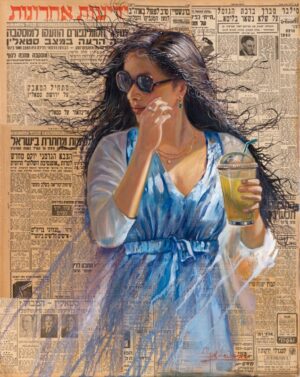
Tel Aviv Painting: Lady in Blue
$275 – $1,160 This product has multiple variants. The options may be chosen on the product page -

Tel Aviv Painting: Life in Tel Aviv
$275 – $1,160 This product has multiple variants. The options may be chosen on the product page -
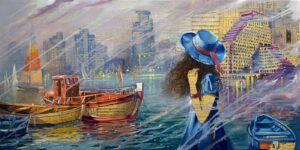
Tel Aviv Painting: Tel Aviv – Non stop City
$275 – $1,740 This product has multiple variants. The options may be chosen on the product page -

Nature Painting: Eretz Yisrael
$195 – $1,160 This product has multiple variants. The options may be chosen on the product page -

Nature Painting: Land of Israel
$195 – $1,160 This product has multiple variants. The options may be chosen on the product page -

Jerusalem Painting: City Walls of Jerusalem
$195 – $1,130 This product has multiple variants. The options may be chosen on the product page -

Jewish Painting: Still Life with Torah
$195 – $1,220 This product has multiple variants. The options may be chosen on the product page -

Israeli Painting: Shema Israel
$195 – $1,220 This product has multiple variants. The options may be chosen on the product page -

Jerusalem Temple Painting: Pilgrimage to the second Jerusalem Temple (Beit HaMikdash)
$235 – $1,390 This product has multiple variants. The options may be chosen on the product page -

Jerusalem Painting: Friday night at the Kotel in Jerusalem
$235 – $1,390 This product has multiple variants. The options may be chosen on the product page -
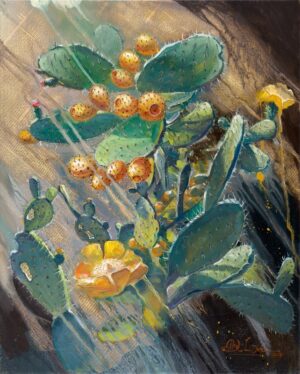
Nature Painting: Tzabar
$275 – $1,160 This product has multiple variants. The options may be chosen on the product page -

Nature Painting: View from Ramat Hagolan
$275 – $795 This product has multiple variants. The options may be chosen on the product page -

Nature Painting: View to Zfat and Meron mountain
$275 – $1,330 This product has multiple variants. The options may be chosen on the product page -

Nature Painting: View from Old Jaffa to Andromeda’s rocks
$95 – $1,130 This product has multiple variants. The options may be chosen on the product page -

Nature Painting: View from Ein Gedi to the Dead Sea
$95 – $1,130 This product has multiple variants. The options may be chosen on the product page -

Nature Painting: Revival of Israel
$195 – $1,350 This product has multiple variants. The options may be chosen on the product page -

Nature Painting: Pomegranate tree in Jerusalem
$195 – $1,220 This product has multiple variants. The options may be chosen on the product page -

Nature Painting: Hagamon Hahula
$95 – $1,130 This product has multiple variants. The options may be chosen on the product page -

Nature Painting: Galilee
$275 – $845 This product has multiple variants. The options may be chosen on the product page -

Nature Painting: Capers – Symbol of strong Israel
$275 – $845 This product has multiple variants. The options may be chosen on the product page -

Nature Painting: Blooming of Aloe in Ein Karem
$275 – $1,350 This product has multiple variants. The options may be chosen on the product page -

Nature Painting: Blooming of Drimia on Masada
$275 – $1,350 This product has multiple variants. The options may be chosen on the product page -

Nature Painting: The Kastel, where the siege of Jerusalem was finally broken
$95 – $970 This product has multiple variants. The options may be chosen on the product page -

Venice Painting: Venetian Fairies
$195 – $1,130 This product has multiple variants. The options may be chosen on the product page -

Venice Painting: Purple Reflection
$275 – $1,140 This product has multiple variants. The options may be chosen on the product page -

Venice Painting: Blue Venetian Dream
$140 – $970 This product has multiple variants. The options may be chosen on the product page -

Venice Painting: Venetian Enchantress
$275 – $845 This product has multiple variants. The options may be chosen on the product page -
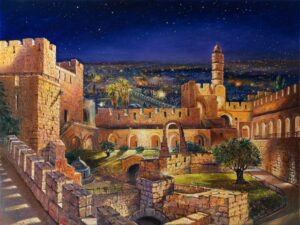
Jerusalem Painting: The Garden of David in the old city of Jerusalem
$195 – $1,220 This product has multiple variants. The options may be chosen on the product page -
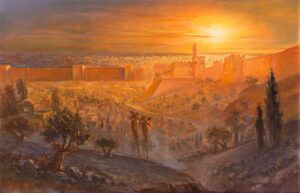
Jerusalem Painting: Sunset over Migdal David in Jerusalem
$195 – $1,390 This product has multiple variants. The options may be chosen on the product page -

Jerusalem Painting: Roofs of Jerusalem
$275 – $2,820 This product has multiple variants. The options may be chosen on the product page -

Jerusalem Painting: Eternal Jerusalem
$275 – $845 This product has multiple variants. The options may be chosen on the product page -
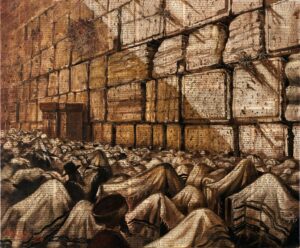
Jewish Painting: Birkat Kohanim in Jerusalem
$195 – $1,130 This product has multiple variants. The options may be chosen on the product page -

Israeli Painting: Long Live Israel
$275 – $1,350 This product has multiple variants. The options may be chosen on the product page -

Jewish Painting: Morning of 1941
$275 – $1,160 This product has multiple variants. The options may be chosen on the product page -

Israeli Painting: My Influential Events
$95 – $970 This product has multiple variants. The options may be chosen on the product page -

Tel Aviv Painting: On Tel Aviv Nahalat Binyamin street
$275 – $1,370 This product has multiple variants. The options may be chosen on the product page -
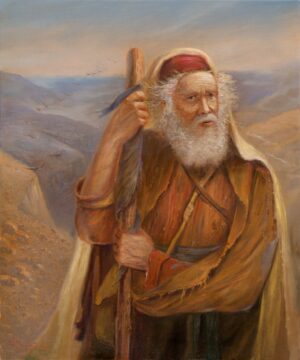
Jewish Painting: Moses at the Promised Land
$195 – $1,130 This product has multiple variants. The options may be chosen on the product page -

Surrealism Painting: Epistle from Renaissance
$95 – $1,130 This product has multiple variants. The options may be chosen on the product page -

Jerusalem Painting: Morning by the Kotel in Jerusalem
$220 – $1,130 This product has multiple variants. The options may be chosen on the product page -

Surrealism Painting: Know thyself
$95 – $970 This product has multiple variants. The options may be chosen on the product page -
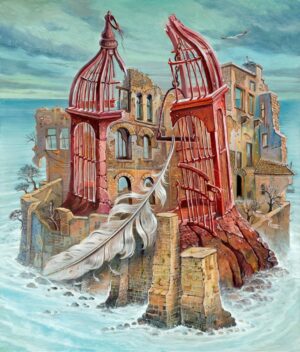
Surrealism Painting: Never too late
$195 – $1,100 This product has multiple variants. The options may be chosen on the product page -

Surrealism Painting: Miracle of Birth
$195 – $1,100 This product has multiple variants. The options may be chosen on the product page -
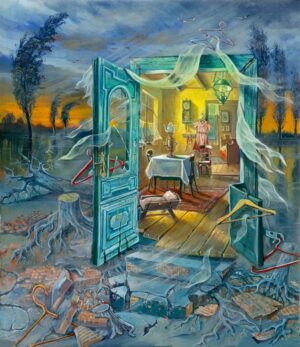
Surrealism Painting: Fear of emptiness or my memories from Poland
$195 – $1,100 This product has multiple variants. The options may be chosen on the product page -
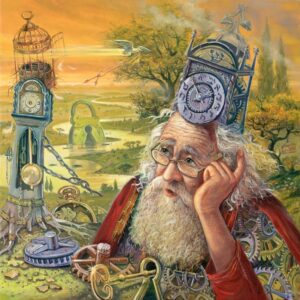
Surrealism Painting: There we sat down and cried – by the rivers of Babylon – as we remembered Zion
$95 – $970 This product has multiple variants. The options may be chosen on the product page -

Surrealism Painting: All is foreseen but freedom of choice is given
$95 – $970 This product has multiple variants. The options may be chosen on the product page -

Surrealism Painting: Escape
$175 – $820 This product has multiple variants. The options may be chosen on the product page -
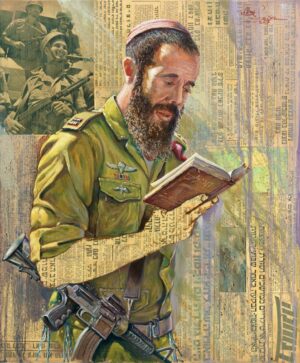
Israeli Painting: Sons of Israel
$220 – $1,130 This product has multiple variants. The options may be chosen on the product page -
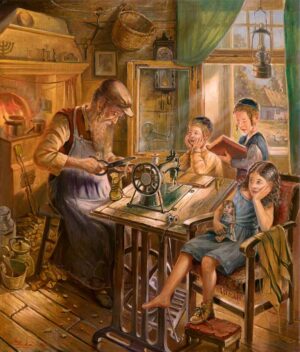
Jewish Painting: Jewish Shoemaker
$195 – $1,100 This product has multiple variants. The options may be chosen on the product page -
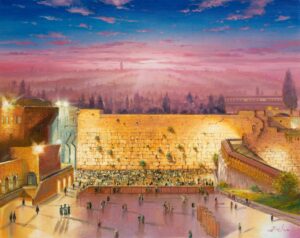
Jerusalem Painting: Sunrise above the Kotel in Jerusalem
$195 – $1,220 This product has multiple variants. The options may be chosen on the product page -

Jerusalem Painting: Next year in Jerusalem
$275 – $1,740 This product has multiple variants. The options may be chosen on the product page -

Israeli Painting: Zionists Proclaim new State of Israel
$95 – $970 This product has multiple variants. The options may be chosen on the product page -

Surrealism Painting: Tower of Babylon
$195 – $1,160 This product has multiple variants. The options may be chosen on the product page -

Jewish Painting: Cheider in Shtetl
$195 – $1,100 This product has multiple variants. The options may be chosen on the product page -

Jewish Painting: Pilgrims by the Cave of Machpelah in Hebron – Tomb of the Patriarchs
$195 – $1,160 This product has multiple variants. The options may be chosen on the product page -
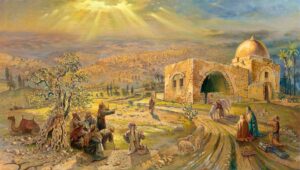
Jewish Painting: Pilgrims by the Rachels Tomb
$235 – $1,580 This product has multiple variants. The options may be chosen on the product page -

Jewish Painting: Sounds of Shofar at Kever Rachel
$195 – $1,100 This product has multiple variants. The options may be chosen on the product page -

Jewish Painting: Tashlich in Shtetl
$195 – $1,280 This product has multiple variants. The options may be chosen on the product page -
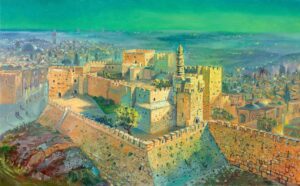
Abstract Jerusalem Painting: The Heavenly Jerusalem
$235 – $1,480 This product has multiple variants. The options may be chosen on the product page -
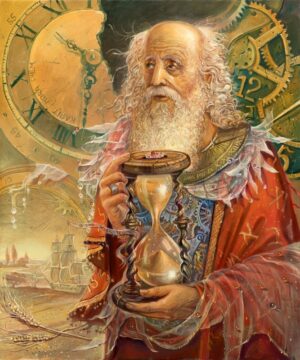
Surrealism Painting: Rapid hora diem – The hour finishes the day
$195 – $1,130 This product has multiple variants. The options may be chosen on the product page -
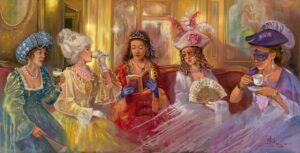
Venice Painting: Venice nightlife in Cafe Florian
$235 – $1,740 This product has multiple variants. The options may be chosen on the product page -

Nature Painting: Almond Blossom around Jerusalem
$195 – $1,130 This product has multiple variants. The options may be chosen on the product page -

Nature Painting: Tragic story of Masada
$195 – $1,160 This product has multiple variants. The options may be chosen on the product page -

Nature Painting: Blooming of Sternbergia Clusiana in Judean Desert
$195 – $1,130 This product has multiple variants. The options may be chosen on the product page -

Nature Painting: Daffodils in the Judean Desert
$95 – $970 This product has multiple variants. The options may be chosen on the product page -

Nature Painting: Poisonous Tree, Apple of Sodom in the natural reserve of Ein Gedi by the Dead Sea
$95 – $970 This product has multiple variants. The options may be chosen on the product page -

Nature Painting: Colchicum from Jerusalem
$235 – $1,740 This product has multiple variants. The options may be chosen on the product page -

Nature Painting: Am Israel Chai
$235 – $1,570 This product has multiple variants. The options may be chosen on the product page -

Nature Painting: Squills by Kineret
$235 – $1,740 This product has multiple variants. The options may be chosen on the product page -

Nature Painting: View from Rosh Pina to Hula Valley
$235 – $1,740 This product has multiple variants. The options may be chosen on the product page -

Nature Painting: Mountains of the Dead Sea Scrolls
$260 – $1,390 This product has multiple variants. The options may be chosen on the product page -

Nature Painting: Bedouin from the Judean Desert
$195 – $1,280 This product has multiple variants. The options may be chosen on the product page -

Nature Painting: Bedouin shepherd
$195 – $1,280 This product has multiple variants. The options may be chosen on the product page -

Jerusalem Painting: Holy Jerusalem
$275 – $2,820 This product has multiple variants. The options may be chosen on the product page -

Jerusalem Painting: The Walls of Jerusalem
$275 – $2,820 This product has multiple variants. The options may be chosen on the product page -

Jerusalem Painting: Jerusalem a City on Seven Hills
$275 – $2,820 This product has multiple variants. The options may be chosen on the product page -

Jerusalem Painting: Sunrise in Holy Jerusalem
$275 – $2,820 This product has multiple variants. The options may be chosen on the product page -

Jerusalem Painting: Jerusalem Old City at Night
$275 – $2,820 This product has multiple variants. The options may be chosen on the product page -

Jerusalem Painting: Sunrise behind the Kotel in Jerusalem
$195 – $1,390 This product has multiple variants. The options may be chosen on the product page -
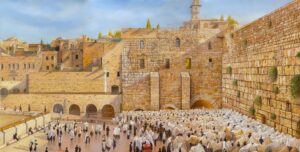
Jerusalem Painting: Birkat Kohanim by the Kotel in Jerusalem
$235 – $1,740 This product has multiple variants. The options may be chosen on the product page -

Jerusalem Painting: Sabbath walk by the David’s Tower in Jerusalem
$235 – $1,740 This product has multiple variants. The options may be chosen on the product page -
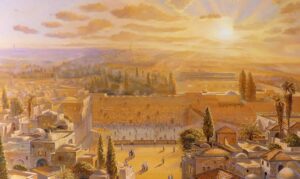
Jerusalem Painting: Jerusalem – The center of the earth, the apple of His eye
$235 – $1,470 This product has multiple variants. The options may be chosen on the product page -

Jerusalem Painting: Welcome to Jerusalem
$235 – $1,740 This product has multiple variants. The options may be chosen on the product page -
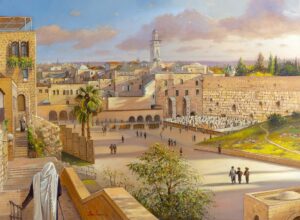
Jerusalem Painting: On the way to the Kotel in Jerusalem
$195 – $1,300 This product has multiple variants. The options may be chosen on the product page -

Jerusalem Painting: Kotel at Night in Jerusalem
$195 – $1,490 This product has multiple variants. The options may be chosen on the product page -
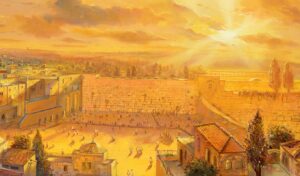
Jerusalem Painting: Sunrise in Holy Jerusalem
$195 – $1,490 This product has multiple variants. The options may be chosen on the product page -

Jerusalem Painting: Holy Jerusalem
$195 – $1,490 This product has multiple variants. The options may be chosen on the product page -
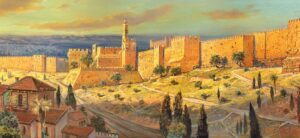
Jerusalem Painting: The walls of Jerusalem
$195 – $1,820 This product has multiple variants. The options may be chosen on the product page -
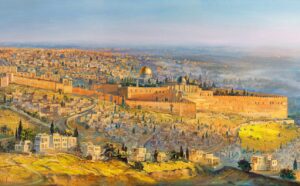
Jerusalem Painting: Jerusalem a city on seven Hills
$195 – $1,480 This product has multiple variants. The options may be chosen on the product page -

Nature Painting: Morning at the Bedouin village of Hamais
$295 – $1,200 This product has multiple variants. The options may be chosen on the product page -

Nature Painting: A Valley of Tears where Israel stopped Syria invasion in 1973
$195 – $1,600 This product has multiple variants. The options may be chosen on the product page -

Nature Painting: Azure sky of Galilea
$195 – $1,280 This product has multiple variants. The options may be chosen on the product page -

Nature Painting: Ein Gedi – Oasis in the Judean desert
$195 – $1,600 This product has multiple variants. The options may be chosen on the product page -

Nature Painting: Magical Hula Valley
$195 – $1,600 This product has multiple variants. The options may be chosen on the product page -

Surrealism Painting: Vivere Militate Est – To live means to fight
$95 – $970 This product has multiple variants. The options may be chosen on the product page -
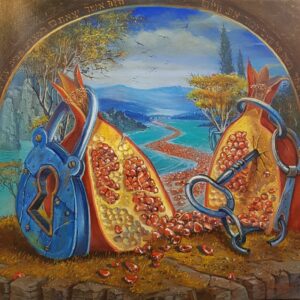
Jewish Surrealism Painting: Remember this day in which you came out from Egypt, out of the house of slavery
$95 – $630 This product has multiple variants. The options may be chosen on the product page -

Surrealism Painting: Kristallnacht November 9th 1938
$195 – $1,160 This product has multiple variants. The options may be chosen on the product page -

Surrealism Painting: Fortes fortuna adiuvat – Fortune favours the bold
$195 – $1,160 This product has multiple variants. The options may be chosen on the product page -

Surrealism Painting: Majdanek
$275 – $1,110 This product has multiple variants. The options may be chosen on the product page -

Jewish Surrealism Painting: Sounds of Sinai
$95 – $970 This product has multiple variants. The options may be chosen on the product page -
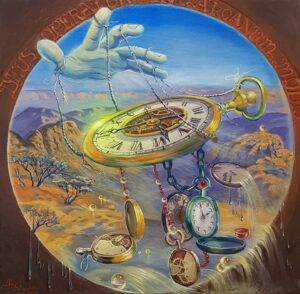
Jewish Surrealism Painting: God works in mysterious ways
$95 – $970 This product has multiple variants. The options may be chosen on the product page -

Surrealism Painting: The die is cast
$275 – $750 This product has multiple variants. The options may be chosen on the product page -

Jerusalem Painting: View at the Kotel in Jerusalem
$195 – $1,160 This product has multiple variants. The options may be chosen on the product page -

Surrealism Painting: Siesta
$195 – $1,160 This product has multiple variants. The options may be chosen on the product page -

Surrealism Painting: The birth of Time
$195 – $1,160 This product has multiple variants. The options may be chosen on the product page -
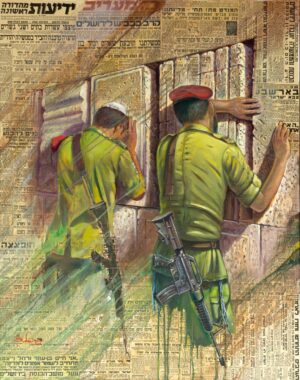
Israeli Painting: Paratroopers at the Western Wall
$195 – $1,180 This product has multiple variants. The options may be chosen on the product page -
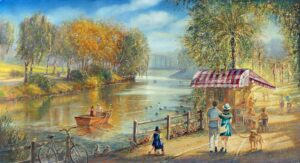
Tel Aviv Painting: Let’s meet in the park HaYarkon, Tel Aviv
$195 – $1,610 This product has multiple variants. The options may be chosen on the product page -
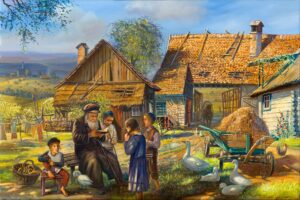
Jewish Painting: Jewish life in Shtetl
$195 – $1,350 This product has multiple variants. The options may be chosen on the product page -

Jewish Painting: Life in shtetl
$195 – $1,490 This product has multiple variants. The options may be chosen on the product page -

Jewish Painting: God gives Moses the 10 commandments written on a stone tablets
$195 – $1,470 This product has multiple variants. The options may be chosen on the product page -

Jewish Painting: Moses crossing the sea
$195 – $1,470 This product has multiple variants. The options may be chosen on the product page -
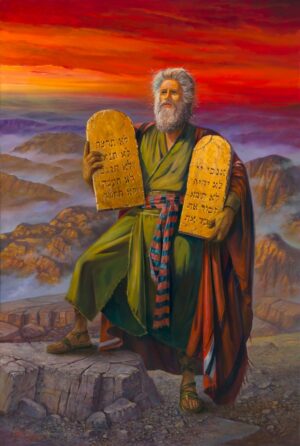
Jewish Painting: The commandments given to Moses at Mount Sinai
$195 – $1,330 This product has multiple variants. The options may be chosen on the product page -

Nature Painting: Flock of sheep in Judean desert
$275 – $1,820 This product has multiple variants. The options may be chosen on the product page -

Nature Painting: Spring in Galilee
$275 – $1,820 This product has multiple variants. The options may be chosen on the product page -
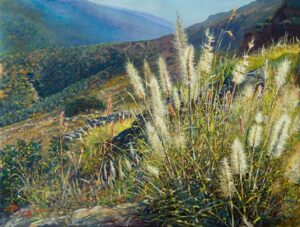
Nature Painting: Spring in Samaria mountains
$195 – $1,220 This product has multiple variants. The options may be chosen on the product page -

Nature Painting: Camels tribe
$195 – $1,220 This product has multiple variants. The options may be chosen on the product page -

Nature Painting: Enchantment of Judean Desert
$195 – $1,160 This product has multiple variants. The options may be chosen on the product page -

Venice Painting: Fly of azure butterfly
$195 – $970 This product has multiple variants. The options may be chosen on the product page -

Venice Painting: Mysterious stranger in rose tone
$195 – $1,140 This product has multiple variants. The options may be chosen on the product page -
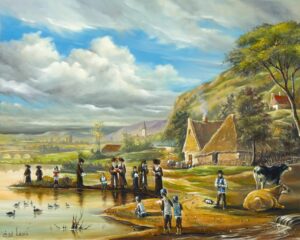
Jewish Painting: Tashlich in Shtetl
$195 – $1,160 This product has multiple variants. The options may be chosen on the product page -
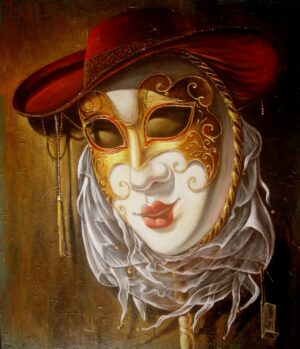
Venice Painting: Casanova
$195 – $1,130 This product has multiple variants. The options may be chosen on the product page -

Jerusalem Temple Painting: The Second Holy Jewish Temple in Jerusalem
$235 – $1,390 This product has multiple variants. The options may be chosen on the product page -

Jerusalem Temple Painting: Light of the Second Jerusalem Temple
$235 – $1,995 This product has multiple variants. The options may be chosen on the product page -

Venice Painting: Queen of Venice
$195 – $1,220 This product has multiple variants. The options may be chosen on the product page -

Venice Painting: Pink Morning
$195 – $1,220 This product has multiple variants. The options may be chosen on the product page -

Abstract Jerusalem Painting: The Creation. A divine spirit floats over the water
$275 – $1,110 This product has multiple variants. The options may be chosen on the product page -

Abstract Jewish Painting: Power of Prayer
$195 – $1,480 This product has multiple variants. The options may be chosen on the product page -

Abstract Jerusalem Painting: Rainy morning by the Western Wall
$275 – $1,110 This product has multiple variants. The options may be chosen on the product page -

Abstract Jerusalem Painting: Jerusalem at Night
$195 – $1,320 This product has multiple variants. The options may be chosen on the product page -

Abstract Jerusalem Painting: Heavenly Jerusalem
$195 – $1,220 This product has multiple variants. The options may be chosen on the product page -

Abstract Jerusalem Painting: Glow from the Golden Gate in Jerusalem
$275 – $1,740 This product has multiple variants. The options may be chosen on the product page -

Abstract Jerusalem Painting: City of David
$195 – $1,160 This product has multiple variants. The options may be chosen on the product page -

Abstract Jerusalem Painting: Next Year in rebuilt Jerusalem
$235 – $1,350 This product has multiple variants. The options may be chosen on the product page -
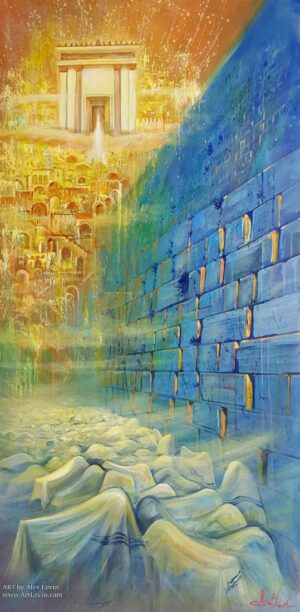
Abstract Jerusalem Painting: If I Forget Thee, O Jerusalem
$275 – $1,740 This product has multiple variants. The options may be chosen on the product page -

Abstract Jewish Painting: The Tomb of the Matriarch Rachel
$235 – $1,350 This product has multiple variants. The options may be chosen on the product page -

Abstract Jerusalem Painting: Jerusalem Rising
$275 – $1,740 This product has multiple variants. The options may be chosen on the product page -

Abstract Jewish Painting: Streets of Tzfat-Safed
$195 – $1,160 This product has multiple variants. The options may be chosen on the product page -

Abstract Jerusalem Painting: Jerusalem of Gold
$275 – $1,740 This product has multiple variants. The options may be chosen on the product page -

Abstract Jerusalem Painting: Jerusalem at Night
$235 – $1,350 This product has multiple variants. The options may be chosen on the product page -

Jerusalem Temple Painting: Rising of the Third Jerusalem Temple
$195 – $1,160 This product has multiple variants. The options may be chosen on the product page -

Abstract Jewish Painting: Tomb of the Patriarchs in Hebron
$195 – $1,060 This product has multiple variants. The options may be chosen on the product page -

Abstract Jewish Painting: Kever Rachel – In need for divine intervention
$195 – $1,220 This product has multiple variants. The options may be chosen on the product page -
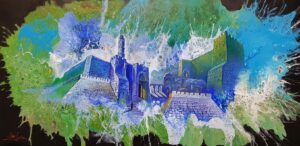
Abstract Jerusalem Painting: Mysteries of Jerusalem
$275 – $1,110 This product has multiple variants. The options may be chosen on the product page -

Abstract Jerusalem Painting: Jerusalem Syndrome
$275 – $1,110 This product has multiple variants. The options may be chosen on the product page -

Abstract Jewish Painting: Surrounding Energy of Chuppah Ceremony
$195 – $1,220 This product has multiple variants. The options may be chosen on the product page -

Jerusalem Temple Painting: Light of the Third Jerusalem Temple
$235 – $1,390 This product has multiple variants. The options may be chosen on the product page -
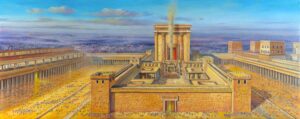
Jerusalem Temple Painting: Temple – The Soul of Jerusalem
$295 – $1,600 This product has multiple variants. The options may be chosen on the product page -
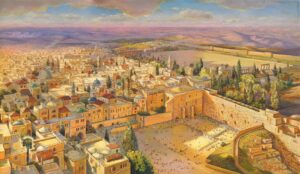
Jerusalem Painting: Birds eye view of the Kotel in Jerusalem
$235 – $1,580 This product has multiple variants. The options may be chosen on the product page -
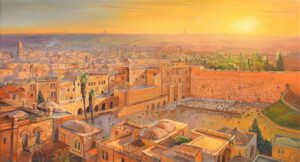
Jerusalem Painting: Sunrise by the Kotel in Jerusalem
$235 – $1,610 This product has multiple variants. The options may be chosen on the product page -
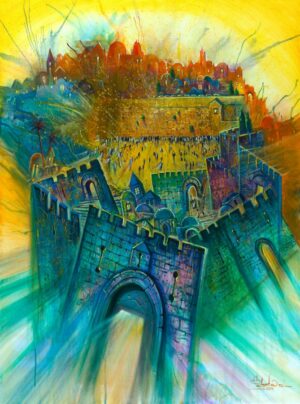
Abstract Jerusalem Painting: Indivisible Jerusalem
$195 – $1,220 This product has multiple variants. The options may be chosen on the product page -
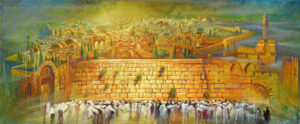
Jerusalem Painting: Jerusalem Light to the nations
$275 – $1,550 This product has multiple variants. The options may be chosen on the product page -

Abstract Jerusalem Painting: Shabbat in Jerusalem
$235 – $1,350 This product has multiple variants. The options may be chosen on the product page -
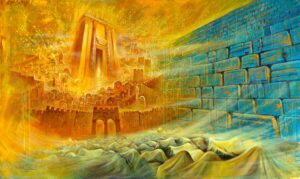
Abstract Jerusalem Painting: Bible Prophecy
$235 – $1,480 This product has multiple variants. The options may be chosen on the product page -

Abstract Jerusalem Painting: Streets in the Old Jerusalem
$235 – $1,220 This product has multiple variants. The options may be chosen on the product page -

Abstract Jerusalem Painting: Jerusalem, the place chosen by God
$195 – $1,160 This product has multiple variants. The options may be chosen on the product page -
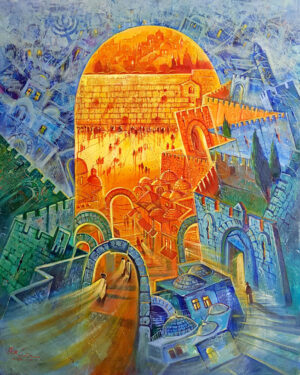
Abstract Jerusalem Painting: The Heavenly Jerusalem and the Earthly Jerusalem
$235 – $1,220 This product has multiple variants. The options may be chosen on the product page -

Abstract Jerusalem Painting: The Coming of Moshiach
$235 – $1,350 This product has multiple variants. The options may be chosen on the product page -

Abstract Jerusalem Painting: Projecting the astonishing energy of Jerusalem
$235 – $1,220 This product has multiple variants. The options may be chosen on the product page -

Abstract Jerusalem Painting: Stones of the Kotel, Entry to Jerusalem
$195 – $1,160 This product has multiple variants. The options may be chosen on the product page -

Abstract Jerusalem Painting: Jerusalem Rhapsody in blue
$235 – $1,220 This product has multiple variants. The options may be chosen on the product page -

Abstract Jerusalem Painting: Jerusalem Vibes
$235 – $1,220 This product has multiple variants. The options may be chosen on the product page -

Abstract Jerusalem Painting: Alluring aura of Jerusalem’s Menorah
$195 – $1,470 This product has multiple variants. The options may be chosen on the product page -

Abstract Jerusalem Painting: Jerusalem – the center of the Universe
$275 – $1,600 This product has multiple variants. The options may be chosen on the product page -

Abstract Jerusalem Painting: Sunrise in Jerusalem the City of David
$235 – $1,220 This product has multiple variants. The options may be chosen on the product page -
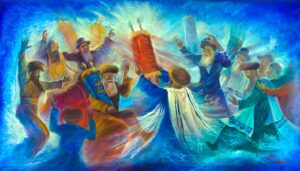
Abstract Jewish Painting: Simchat Torah Celebration
$235 – $1,580 This product has multiple variants. The options may be chosen on the product page -

Abstract Jerusalem Painting: Ascending towards the Light
$235 – $1,220 This product has multiple variants. The options may be chosen on the product page -

Abstract Jerusalem Painting: Golden stones of Jerusalem
$195 – $1,160 This product has multiple variants. The options may be chosen on the product page -

Abstract Jerusalem Painting: Light of Jerusalem
$235 – $1,350 This product has multiple variants. The options may be chosen on the product page -

Abstract Jerusalem Painting: Steps to heavenly Jerusalem
$195 – $1,160 This product has multiple variants. The options may be chosen on the product page -

Abstract Jerusalem Painting: Shema Yisrael throughout Jerusalem
$195 – $1,160 This product has multiple variants. The options may be chosen on the product page -

Abstract Jerusalem Painting: Jerusalem in motion
$235 – $1,220 This product has multiple variants. The options may be chosen on the product page -
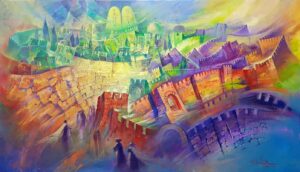
Abstract Jerusalem Painting: The sounds of Jerusalem
$235 – $1,580 This product has multiple variants. The options may be chosen on the product page -
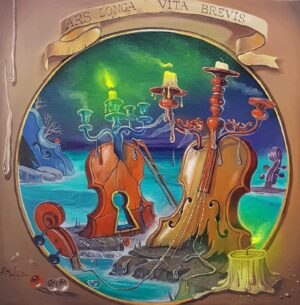
Surrealism Painting: Art is long, life is short
$95 – $970 This product has multiple variants. The options may be chosen on the product page -

Jewish Surrealism Painting: Viva Israel
$95 – $970 This product has multiple variants. The options may be chosen on the product page -
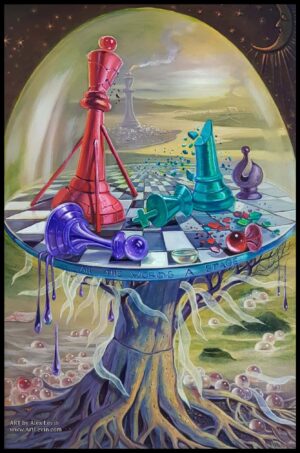
Surrealism Painting: All the worlds stage
$195 – $1,130 This product has multiple variants. The options may be chosen on the product page -

Surrealism Painting: Errare humanum est
$195 – $1,130 This product has multiple variants. The options may be chosen on the product page -

Surrealism Painting: Moments always replacing each other
$195 – $1,130 This product has multiple variants. The options may be chosen on the product page -

Surrealism Painting: Biological Clock
$235 – $1,350 This product has multiple variants. The options may be chosen on the product page -

Surrealism Painting: No time to waste
$195 – $1,160 This product has multiple variants. The options may be chosen on the product page -

Surrealism Painting: Omnia fert aetas ? Time cancels everything
$195 – $1,220 This product has multiple variants. The options may be chosen on the product page -

Abstract Jerusalem Painting: Jerusalem Sensation
$235 – $1,350 This product has multiple variants. The options may be chosen on the product page -

Abstract Jerusalem Painting: Jerusalem Window
$275 – $1,550 This product has multiple variants. The options may be chosen on the product page -

Jerusalem Painting: Zion Gate in Jerusalem
$220 – $1,130 This product has multiple variants. The options may be chosen on the product page -

Surrealism Painting: Value your time
$235 – $1,480 This product has multiple variants. The options may be chosen on the product page -

Surrealism Painting: Motherhood
$195 – $1,160 This product has multiple variants. The options may be chosen on the product page -

Surrealism Painting: Self Discovery
$95 – $970 This product has multiple variants. The options may be chosen on the product page -

Surrealism Painting: Creation
$195 – $915 This product has multiple variants. The options may be chosen on the product page -

Surrealism Painting: Secrets of musical pears
$195 – $915 This product has multiple variants. The options may be chosen on the product page -
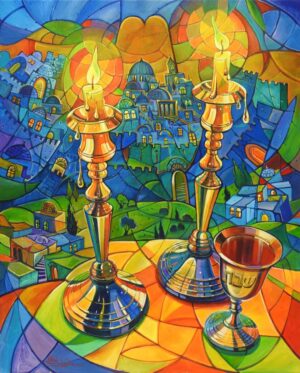
Abstract Jewish Painting: Shabbat in Jerusalem
$195 – $1,220 This product has multiple variants. The options may be chosen on the product page -

Jewish Painting: Morning in the Cheder at the old Shtetl
$195 – $1,280 This product has multiple variants. The options may be chosen on the product page -
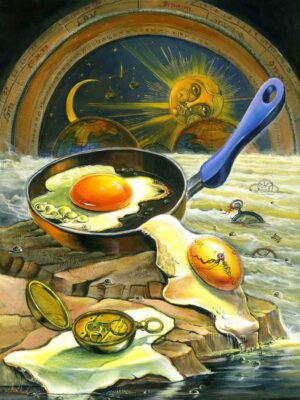
Surrealism Painting: Runaway Time
$235 – $1,220 This product has multiple variants. The options may be chosen on the product page -
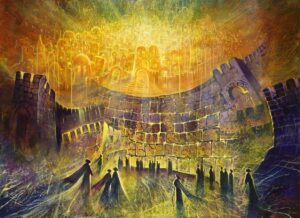
Abstract Jerusalem Painting: Emerge of a new day in Jerusalem
$235 – $1,220 This product has multiple variants. The options may be chosen on the product page -
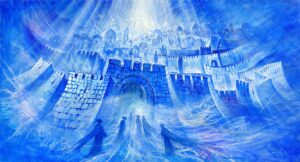
Abstract Jerusalem Painting: Blue Euphoria
$275 – $1,110 This product has multiple variants. The options may be chosen on the product page -

Abstract Jerusalem Painting: Power, alluring to Jerusalem
$195 – $1,600 This product has multiple variants. The options may be chosen on the product page -

Abstract Jerusalem Painting: One City of Three Faiths Jerusalem a sacred city for three religions
$275 – $1,110 This product has multiple variants. The options may be chosen on the product page -

Abstract Jerusalem Painting: Kabbalat Shabbat at the Kotel in Jerusalem
$275 – $1,110 This product has multiple variants. The options may be chosen on the product page -

Painting: Mister Jazz
$195 – $915 This product has multiple variants. The options may be chosen on the product page -

Abstract Jerusalem Painting: Jerusalem at Night
$275 – $1,110 This product has multiple variants. The options may be chosen on the product page -
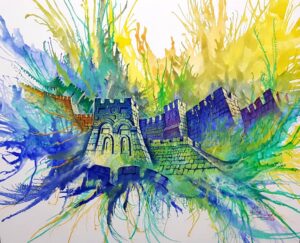
Abstract Jerusalem Painting: Gates of Mercy on the Temple Mount in Jerusalem
$195 – $1,160 This product has multiple variants. The options may be chosen on the product page -

Abstract Jerusalem Painting: Awaiting the Coming of the Messiah in Jerusalem
$195 – $1,160 This product has multiple variants. The options may be chosen on the product page -

Abstract Jewish Painting: Jewish Dance
$195 – $1,490 This product has multiple variants. The options may be chosen on the product page -

Jewish Painting: Judgment of Solomon
$220 – $1,130 This product has multiple variants. The options may be chosen on the product page -

Nature Painting: Sea of Galilee
$195 – $915 This product has multiple variants. The options may be chosen on the product page -

Abstract Jewish Painting: Woman honoring the Shabbat
$235 – $1,220 This product has multiple variants. The options may be chosen on the product page -

Abstract Jewish Painting: Light Unto the Nations
$235 – $1,220 This product has multiple variants. The options may be chosen on the product page -

Abstract Jewish Painting: Chuppah on the streets of Jerusalem
$95 – $970 This product has multiple variants. The options may be chosen on the product page -
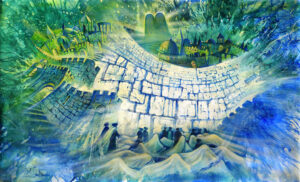
Abstract Jerusalem Painting: Pathway to the Third Jerusalem Temple
$195 – $1,490 This product has multiple variants. The options may be chosen on the product page -

Abstract Jerusalem Painting: Jerusalem – Aspiration of truth
$195 – $1,600 This product has multiple variants. The options may be chosen on the product page -

Abstract Jerusalem Painting: The spirit of Jerusalem
$235 – $1,350 This product has multiple variants. The options may be chosen on the product page -
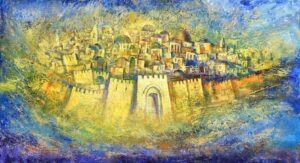
Abstract Jerusalem Painting: Jerusalem of Gold
$275 – $1,110 This product has multiple variants. The options may be chosen on the product page -
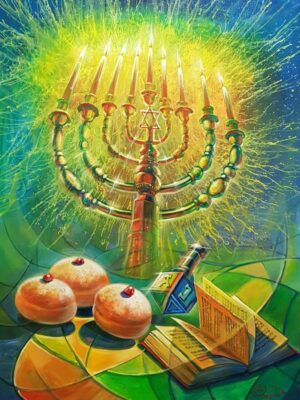
Abstract Jewish Painting: Hanukkah – The Jewish Festival of Lights
$195 – $1,130 This product has multiple variants. The options may be chosen on the product page -
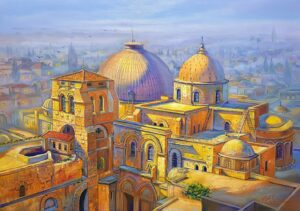
Jerusalem Painting: Sunrise over the Church of Holy Sepulchre in the Christian Quarter of the Old City of Jerusalem
$195 – $1,800 This product has multiple variants. The options may be chosen on the product page -

Abstract Jerusalem Painting: Jerusalem – City of light and wisdom
$195 – $1,490 This product has multiple variants. The options may be chosen on the product page -
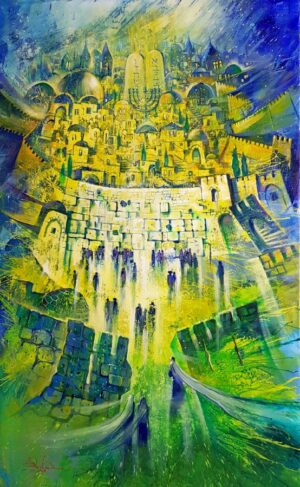
Abstract Jerusalem Painting: All the paths leads to the holy city of Jerusalem
$195 – $1,490 This product has multiple variants. The options may be chosen on the product page -

Abstract Jerusalem Painting: Street in Jerusalem
$195 – $1,800 This product has multiple variants. The options may be chosen on the product page -

Tel Aviv Painting: Rainy day in Israel
$235 – $1,220 This product has multiple variants. The options may be chosen on the product page -

Surrealism Painting: Memento Mori
$95 – $800 This product has multiple variants. The options may be chosen on the product page -

Surrealism Painting: Only the time belongs to us
$235 – $610 This product has multiple variants. The options may be chosen on the product page -

Surrealism Painting: First days of Creation
$195 – $1,490 This product has multiple variants. The options may be chosen on the product page -

Tel Aviv Painting: First Jewish repatriate building Tel Aviv in 1920
$235 – $890 This product has multiple variants. The options may be chosen on the product page -

Israeli Painting: Moshe Dayan and Ariel Sharon, Heroes of Israel
$195 – $1,180 This product has multiple variants. The options may be chosen on the product page -

Israeli Painting: Ben Gurion, The founder of the State of Israel
$195 – $1,280 This product has multiple variants. The options may be chosen on the product page -

Jewish Painting: Jewish eyes, Resident of Jerusalem
$195 – $800 This product has multiple variants. The options may be chosen on the product page -

Surrealism Painting: Self Portrait or Still life with Sunflowers
$235 – $610 This product has multiple variants. The options may be chosen on the product page -

Jewish Painting: Childhood in the Shtetl
$195 – $1,220 This product has multiple variants. The options may be chosen on the product page -
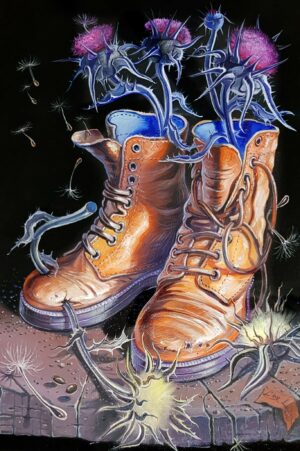
Israeli Painting: Am Yisrael Chai
$235 – $610 This product has multiple variants. The options may be chosen on the product page -
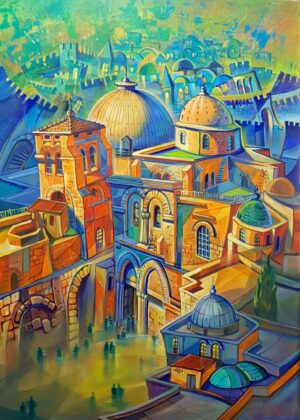
Abstract Jerusalem Painting: Church of the Holy Sepulchre in Jerusalem
$195 – $1,800 This product has multiple variants. The options may be chosen on the product page -
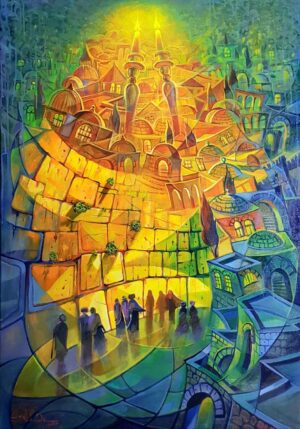
Abstract Jerusalem Painting: Shabbat covering Jerusalem
$195 – $995 This product has multiple variants. The options may be chosen on the product page -

Abstract Jerusalem Painting: Shema Yisrael
$235 – $1,220 This product has multiple variants. The options may be chosen on the product page -

Abstract Jerusalem Painting: Earthly Jerusalem meets heavenly Jerusalem
$195 – $1,490 This product has multiple variants. The options may be chosen on the product page -

Abstract Jerusalem Painting: The Heart of Jerusalem
$275 – $1,740 This product has multiple variants. The options may be chosen on the product page -

Jerusalem Painting: Golden Jerusalem
$195 – $1,490 This product has multiple variants. The options may be chosen on the product page -

Abstract Jerusalem Painting: Sunrise in Holy Jerusalem
$235 – $1,350 This product has multiple variants. The options may be chosen on the product page -

Abstract Jewish Painting: Receiving the Torah on the mount Sinai
$195 – $1,160 This product has multiple variants. The options may be chosen on the product page -

Abstract Jerusalem Painting: Abstract Colors of Jerusalem
$275 – $1,740 This product has multiple variants. The options may be chosen on the product page -

Jewish Surrealism Painting: Exodus from the diaspora to the Land of Israel
$95 – $970 This product has multiple variants. The options may be chosen on the product page -

Abstract Jaffa Painting: Old Jaffa Port
$235 – $1,350 This product has multiple variants. The options may be chosen on the product page -

Jewish Painting: The Lubavitcher Rebbe, Rabbi Menachem Mendel Schneerson
$195 – $1,220 This product has multiple variants. The options may be chosen on the product page -

Abstract Jaffa Painting: Morning in Old Jaffa Port
$195 – $1,610 This product has multiple variants. The options may be chosen on the product page -

Abstract Jewish Painting: Mother Rachel gives blessings to sons of Israel
$195 – $1,160 This product has multiple variants. The options may be chosen on the product page -

Abstract Jewish Painting: Hanukkah in Jerusalem – Jewish Festival of Lights
$235 – $1,220 This product has multiple variants. The options may be chosen on the product page -

Abstract Jerusalem Painting: Jerusalem – The glory of Zion
$275 – $1,740 This product has multiple variants. The options may be chosen on the product page -
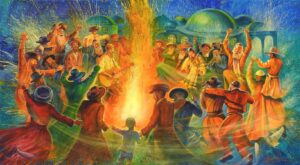
Abstract Jewish Painting: Lag Baomer on mount Meron
$275 – $1,580 This product has multiple variants. The options may be chosen on the product page -
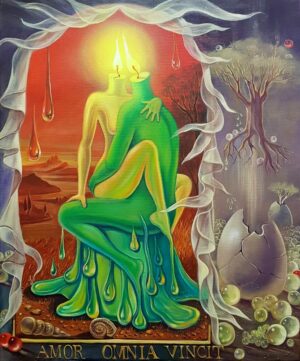
Surrealism Painting: Amor Omnia Vincit
$195 – $915 This product has multiple variants. The options may be chosen on the product page -

Abstract Jewish Painting: Woman lighting Shabbat Candles in Jerusalem
$235 – $1,220 This product has multiple variants. The options may be chosen on the product page -

Jerusalem Temple Painting: Rebuilt Jerusalem Temple welcomes the sons of Israel
$235 – $1,220 This product has multiple variants. The options may be chosen on the product page -

Surrealism Painting: What is life without freedom
$195 – $1,490 This product has multiple variants. The options may be chosen on the product page -
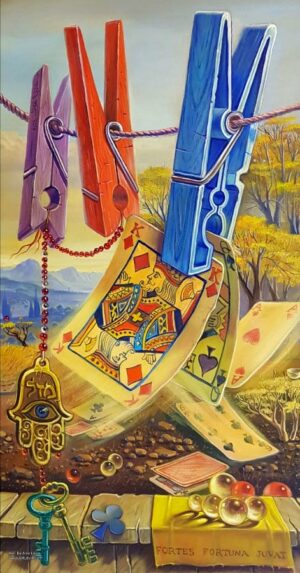
Surrealism Painting: I’m here to Win
$275 – $750 This product has multiple variants. The options may be chosen on the product page -
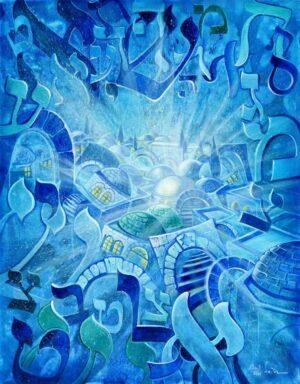
Abstract Jewish Painting: Tzfat – The City of Air and Kabbalah
$225 – $1,220 This product has multiple variants. The options may be chosen on the product page -
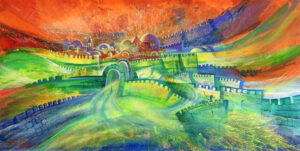
Abstract Jerusalem Painting: Jerusalem – Jerusalem Walls
$275 – $1,740 This product has multiple variants. The options may be chosen on the product page -

Abstract Jerusalem Painting: Shema Israel
$195 – $1,350 This product has multiple variants. The options may be chosen on the product page -

Surrealism Painting: Each person is the creator of his own destiny
$195 – $915 This product has multiple variants. The options may be chosen on the product page -

Tel Aviv Painting: On the way to the Carmel Market in Tel Aviv
$275 – $1,370 This product has multiple variants. The options may be chosen on the product page -

Nature Painting: Poppies on the Biblical Land
$275 – $795 This product has multiple variants. The options may be chosen on the product page -

Jerusalem Painting: Street of Jerusalem at night
$235 – $1,110 This product has multiple variants. The options may be chosen on the product page -

Jerusalem Temple Painting: Call of the Third Eternal Jerusalem Temple
$95 – $970 This product has multiple variants. The options may be chosen on the product page -

Jewish Surrealism Painting: Yom Kippur The day of atonement
$195 – $1,160 This product has multiple variants. The options may be chosen on the product page -

Surrealism Painting: Take your chance
$195 – $1,160 This product has multiple variants. The options may be chosen on the product page -

Abstract Jerusalem Painting: Light of Holy Jerusalem
$195 – $1,490 This product has multiple variants. The options may be chosen on the product page -

Abstract Jewish Painting: The power of Jewish music
$195 – $995 This product has multiple variants. The options may be chosen on the product page -

Abstract Jewish Painting: Jewish Dance
$235 – $1,220 This product has multiple variants. The options may be chosen on the product page -

Abstract Jerusalem Painting: Jerusalem, The path of joy
$275 – $1,740 This product has multiple variants. The options may be chosen on the product page -

Abstract Jewish Painting: Hasidic Dance
$195 – $915 This product has multiple variants. The options may be chosen on the product page -

Abstract Jerusalem Painting: Jerusalem Rising
$195 – $915 This product has multiple variants. The options may be chosen on the product page -

Abstract Jewish Painting: Energy of the Hasidic dance
$195 – $1,160 This product has multiple variants. The options may be chosen on the product page -
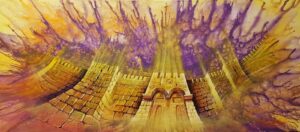
Abstract Jerusalem Painting: The Jerusalem Syndrome
$275 – $1,740 This product has multiple variants. The options may be chosen on the product page -

Abstract Jewish Painting: Power of the Jewish dance
$235 – $1,160 This product has multiple variants. The options may be chosen on the product page -

Surrealism Painting: Ars Longa, Vita Brevis
$195 – $745 This product has multiple variants. The options may be chosen on the product page -

Surrealism Painting: Leave your mark
$235 – $480 This product has multiple variants. The options may be chosen on the product page -

Surrealism Painting: Rainy Days
$235 – $560 This product has multiple variants. The options may be chosen on the product page -

Jerusalem Temple Painting: Isaiah’s prophecy – Third Jerusalem Temple
$95 – $970 This product has multiple variants. The options may be chosen on the product page -

Abstract Jerusalem Painting: If I forget thee, O Jerusalem, let my right hand forget her cunning
$235 – $1,220 This product has multiple variants. The options may be chosen on the product page -

Abstract Jewish Painting: Jewish Dance
$235 – $1,350 This product has multiple variants. The options may be chosen on the product page -

Abstract Jewish Painting: Soul of Jewish Music
$195 – $915 This product has multiple variants. The options may be chosen on the product page -
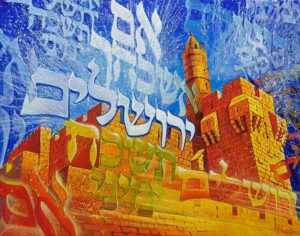
Abstract Jerusalem Painting: If I forget thee, O Jerusalem, let my right hand forget her cunning
$195 – $1,160 This product has multiple variants. The options may be chosen on the product page -

Tel Aviv Painting: Rainy street of Tel Aviv
$235 – $1,220 This product has multiple variants. The options may be chosen on the product page -

Tel Aviv Painting: First rain in Tel Aviv
$275 – $1,370 This product has multiple variants. The options may be chosen on the product page -

Abstract Jerusalem Painting: The Glory of Jerusalem
$275 – $1,110 This product has multiple variants. The options may be chosen on the product page -

Abstract Jerusalem Painting: Aliyah to Jerusalem
$275 – $1,740 This product has multiple variants. The options may be chosen on the product page -

Jewish Painting: Woman lighting Shabbat Candles in Shtetl
$195 – $915 This product has multiple variants. The options may be chosen on the product page -

Abstract Jerusalem Painting: If I forget O Jerusalem
$195 – $915 This product has multiple variants. The options may be chosen on the product page -

Nature Painting: Rainy days in Golan Heights
$275 – $850 This product has multiple variants. The options may be chosen on the product page -

Jerusalem Temple Painting: Eternal Call of the Third Temple in Jerusalem
$195 – $1,600 This product has multiple variants. The options may be chosen on the product page -

Jerusalem Temple Painting: Jerusalem Temple – light at the end of the Tunnel of Eternity
$195 – $1,160 This product has multiple variants. The options may be chosen on the product page -

Abstract Jewish Painting: Tzfat-Safed city of Kabbalah Light
$275 – $1,110 This product has multiple variants. The options may be chosen on the product page -
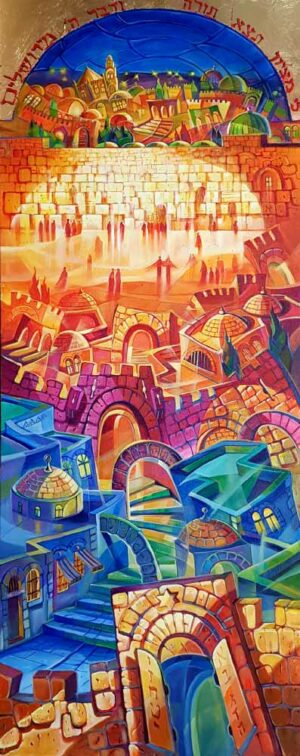
Abstract Jerusalem Painting: Sacred way to the Kotel thru the arches of Jerusalem
$275 – $1,370 This product has multiple variants. The options may be chosen on the product page -

Abstract Jewish Painting: Mystique gust of Kabbalah in Tzfat-Safed
$195 – $1,160 This product has multiple variants. The options may be chosen on the product page -

Surrealism Painting: Music and the Muses
$195 – $545 This product has multiple variants. The options may be chosen on the product page -

Abstract Jewish Painting: Light to the Nations
$235 – $1,350 This product has multiple variants. The options may be chosen on the product page -

Surrealism Painting: Exodus
$195 – $545 This product has multiple variants. The options may be chosen on the product page -

Jerusalem Painting: Kotel at the morning time
$235 – $830 This product has multiple variants. The options may be chosen on the product page -

Jerusalem Temple Painting: Smoke Pillar arising from Jerusalem Temple
$235 – $1,740 This product has multiple variants. The options may be chosen on the product page -

Surrealism Painting: A little bit of light can dispel the darkness
$95 – $625 This product has multiple variants. The options may be chosen on the product page -

Jerusalem Temple Painting: Jerusalem Temple is waiting for you
$235 – $1,740 This product has multiple variants. The options may be chosen on the product page -

Jerusalem Monochrome Painting: Stones of Jerusalem
$195 – $995 This product has multiple variants. The options may be chosen on the product page -

Jerusalem Monochrome Painting: The spirit of Jerusalem
$195 – $995 This product has multiple variants. The options may be chosen on the product page -

Jewish Monochrome Painting: Energy of the Hasidic dance
$195 – $995 This product has multiple variants. The options may be chosen on the product page -

Jerusalem Monochrome Painting: Jerusalem Light to the nations
$210 – $845 This product has multiple variants. The options may be chosen on the product page -

Jerusalem Monochrome Painting: Kabbalat Shabbat at the Kotel in Jerusalem
$210 – $845 This product has multiple variants. The options may be chosen on the product page -

Jerusalem Monochrome Painting: City of David
$195 – $995 This product has multiple variants. The options may be chosen on the product page -
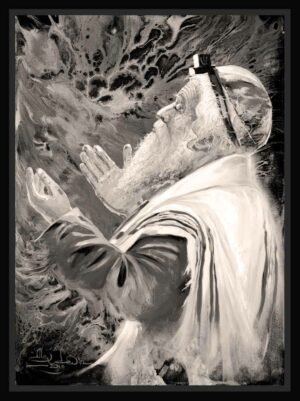
Jewish Monochrome Painting: Shema Israel
$195 – $995 This product has multiple variants. The options may be chosen on the product page -

Jerusalem Monochrome Painting: Glow from the Golden Gate in Jerusalem
$210 – $845 This product has multiple variants. The options may be chosen on the product page -
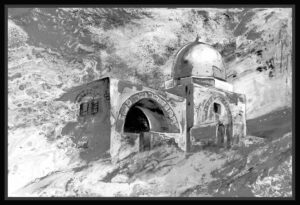
Jewish Monochrome Painting: The Tomb of the Matriarch Rachel
$195 – $995 This product has multiple variants. The options may be chosen on the product page -
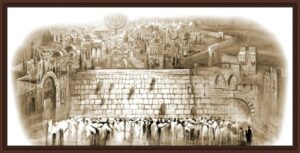
Jerusalem Monochrome Painting: Jerusalem Light to the nations
$210 – $845 This product has multiple variants. The options may be chosen on the product page -

Jewish Monochrome Painting: Shema Yisrael
$195 – $995 This product has multiple variants. The options may be chosen on the product page -

Jewish Monochrome Painting: To the Light
$195 – $995 This product has multiple variants. The options may be chosen on the product page -

Abstract Jerusalem Painting: Jerusalem Light of the World
$275 – $1,740 This product has multiple variants. The options may be chosen on the product page -

Surrealism Painting: Be Careful with Your Time
$235 – $610 This product has multiple variants. The options may be chosen on the product page -

Surrealism Painting: We lived and established and reached this time
$195 – $545 This product has multiple variants. The options may be chosen on the product page -

Jerusalem Painting: Golden Serenade of Jerusalem
$195 – $1,480 This product has multiple variants. The options may be chosen on the product page -

Surrealism Painting: View to Golan Heights
$195 – $545 This product has multiple variants. The options may be chosen on the product page -
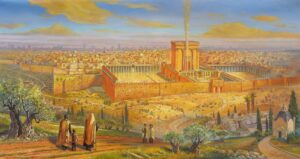
Jerusalem Temple Painting: Road to the Temple
$275 – $1,740 This product has multiple variants. The options may be chosen on the product page -

Abstract Jerusalem Painting: 12 Tribes of Israel
$235 – $1,390 This product has multiple variants. The options may be chosen on the product page -

Abstract Jerusalem Painting: Foggy morning in Jerusalem
$275 – $1,740 This product has multiple variants. The options may be chosen on the product page -
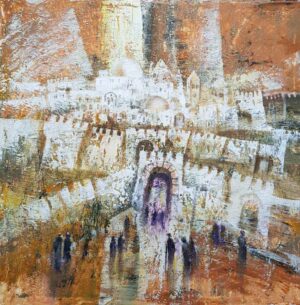
Abstract Jerusalem Painting: Zion Gate of Jerusalem
$95 – $970 This product has multiple variants. The options may be chosen on the product page -

Painting: Old Jaffa Port
$95 – $820 This product has multiple variants. The options may be chosen on the product page -

Abstract Jerusalem Painting: Jerusalem light radiating out into the world
$235 – $935 This product has multiple variants. The options may be chosen on the product page -

Abstract Jerusalem Painting: Praying with you, Oh Jerusalem
$275 – $1,110 This product has multiple variants. The options may be chosen on the product page -

Jerusalem Painting: The Life of the Ultra Orthodox District of Jerusalem, Mea Shearim
$220 – $1,130 This product has multiple variants. The options may be chosen on the product page -

Abstract Jerusalem Painting: Shabbat Kodesh
$195 – $1,160 This product has multiple variants. The options may be chosen on the product page -

Surrealism Painting: Eternal beauty and harmony
$195 – $545 This product has multiple variants. The options may be chosen on the product page -
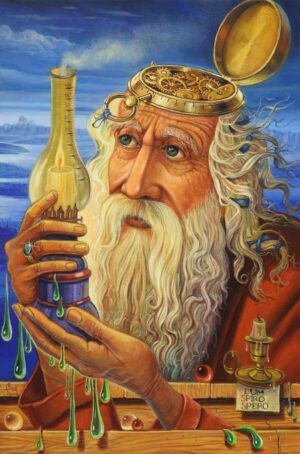
Surrealism Painting: While I breathe, I hope
$235 – $610 This product has multiple variants. The options may be chosen on the product page -

Surrealism Painting: Be Conscious of Your Time
$235 – $610 This product has multiple variants. The options may be chosen on the product page -

Abstract Jerusalem Painting: Holiness of Jerusalem
$95 – $970 This product has multiple variants. The options may be chosen on the product page -
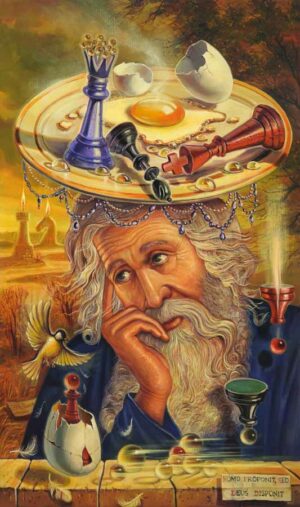
Surrealism Painting: Man proposes God disposes
$275 – $750 This product has multiple variants. The options may be chosen on the product page -
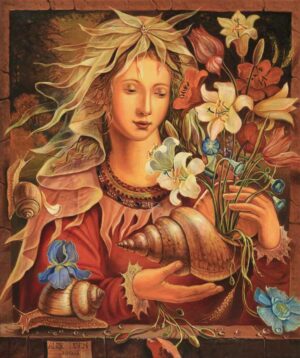
Renaissance Surrealism Painting: Flora
$195 – $545 This product has multiple variants. The options may be chosen on the product page -
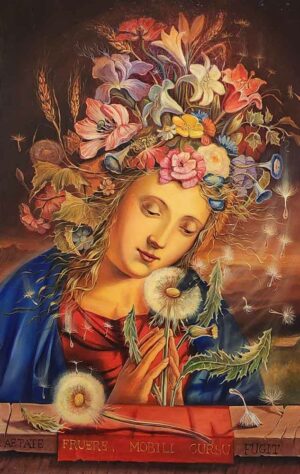
Renaissance Surrealism Painting: Еnjoy life it is so fleeting
$235 – $1,480 This product has multiple variants. The options may be chosen on the product page -

Renaissance Surrealism Painting: Coral Woman
$95 – $970 This product has multiple variants. The options may be chosen on the product page -

Nature Painting: Emek Ahula in Upper Galilee
$195 – $915 This product has multiple variants. The options may be chosen on the product page -

Nature Painting: Spring on Holland Heights
$95 – $970 This product has multiple variants. The options may be chosen on the product page -

Nature Painting: View on the Holland Heights
$95 – $970 This product has multiple variants. The options may be chosen on the product page -

Nature Painting: Mount Gamla
$195 – $915 This product has multiple variants. The options may be chosen on the product page -

Nature Painting: Flowers on Mount Tabor
$95 – $970 This product has multiple variants. The options may be chosen on the product page -

Jerusalem Temple Painting: Temple in Jerusalem – the light of the world
$235 – $1,220 This product has multiple variants. The options may be chosen on the product page -

Nature Painting: Bedouins mother
$195 – $935 This product has multiple variants. The options may be chosen on the product page -

Abstract Jerusalem Painting: The light of Maccabees
$275 – $1,740 This product has multiple variants. The options may be chosen on the product page -

Jerusalem Painting: Kotel at Night
$275 – $1,740 This product has multiple variants. The options may be chosen on the product page -

Jewish Painting: Exodus Crossing Moses and the Red Sea
$195 – $1,220 This product has multiple variants. The options may be chosen on the product page -

Jewish Painting: Reading the Scroll of Esther
$95 – $970 This product has multiple variants. The options may be chosen on the product page -
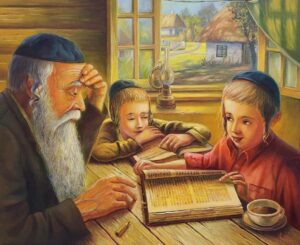
Jewish Painting: Torah lesson in shtetl
$195 – $1,160 This product has multiple variants. The options may be chosen on the product page -

Jewish Painting: Studying Traditions in the Hebrew School in shtetl
$195 – $1,160 This product has multiple variants. The options may be chosen on the product page -

Jewish Painting: A grandfather and his grandchildren in Study
$195 – $1,160 This product has multiple variants. The options may be chosen on the product page -

Jewish Painting: Lesson in the Hebrew school in shtetl
$195 – $1,160 This product has multiple variants. The options may be chosen on the product page -

Jewish Painting: An Afternoon in the Shtetls Hebrew School
$195 – $1,160 This product has multiple variants. The options may be chosen on the product page -

Abstract Jerusalem Painting: Two Temples Two Flames of Jerusalem History
$235 – $1,350 This product has multiple variants. The options may be chosen on the product page -
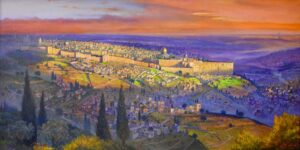
Jerusalem Painting: Jerusalem the center of the world
$235 – $1,110 This product has multiple variants. The options may be chosen on the product page -
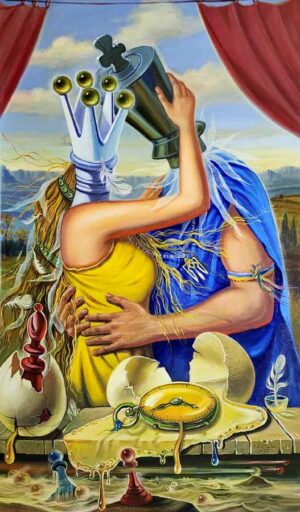
Surrealism Painting: Formation of the New?Nation
$195 – $1,130 This product has multiple variants. The options may be chosen on the product page -

Jerusalem Temple Painting: The Second Jerusalem Temple Ascending into the Clouds
$235 – $1,390 This product has multiple variants. The options may be chosen on the product page -

Surrealism Painting: You cant make an omelet without breaking eggs
$95 – $970 This product has multiple variants. The options may be chosen on the product page -

Renaissance Surrealism Painting: Musical Journey of Violins and Jellyfish
$95 – $970 This product has multiple variants. The options may be chosen on the product page -

Abstract Jerusalem Painting: Jerusalem Kaleidoscope
$275 – $795 This product has multiple variants. The options may be chosen on the product page -

Israeli Painting: Israeli Paratrooper in Prayer While Fulfilling His Duty
$220 – $1,130 This product has multiple variants. The options may be chosen on the product page -
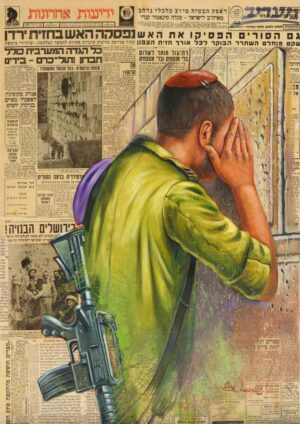
Israeli Painting: Between Duty and Faith
$195 – $1,220 This product has multiple variants. The options may be chosen on the product page -

Abstract Jerusalem Painting: Spiritual Awakening of Jerusalem
$275 – $1,740 This product has multiple variants. The options may be chosen on the product page -
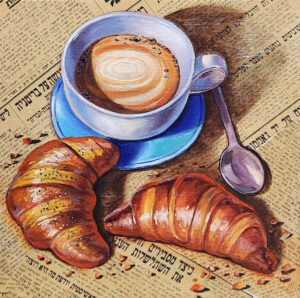
Israeli Painting: Morning in Israel, croissant and coffee
$95 – $630 This product has multiple variants. The options may be chosen on the product page -

Israeli Painting: Morning in Israel, croissant with tea and lemon
$95 – $630 This product has multiple variants. The options may be chosen on the product page -

Jewish Painting: The Gaze Across Centuries
$95 – $970 This product has multiple variants. The options may be chosen on the product page -

Jewish Painting: The gaze of Abraham into infinity
$95 – $970 This product has multiple variants. The options may be chosen on the product page -

Jewish Painting: Light of Generations
$195 – $1,160 This product has multiple variants. The options may be chosen on the product page -
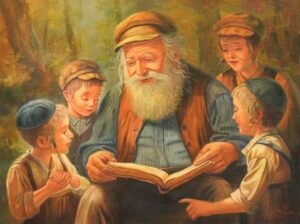
Jewish Painting: Lessons of Faith
$195 – $1,220 This product has multiple variants. The options may be chosen on the product page -
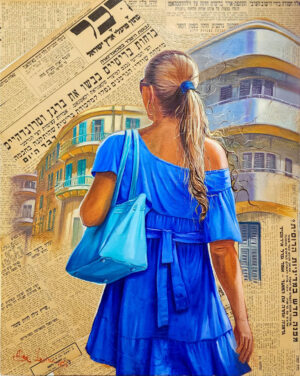
Tel Aviv Painting: A Walk Through the Ages Tel Aviv in the Mirror of Time
$275 – $1,160 This product has multiple variants. The options may be chosen on the product page -
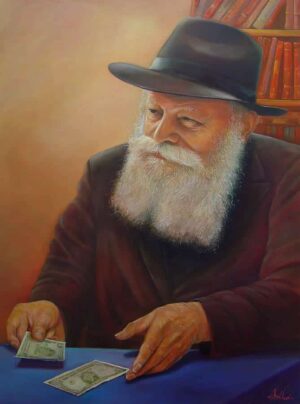
Jewish Painting: Distribution of Dollars by Lubavitcher Rebbe, Rabbi Menachem Mendel Schneerson
$195 – $770 This product has multiple variants. The options may be chosen on the product page -
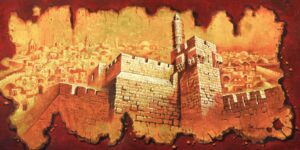
Abstract Jerusalem Painting: The Tower of David and the Magical Scrolls of the Dead Sea
$275 – $1,740 This product has multiple variants. The options may be chosen on the product page -
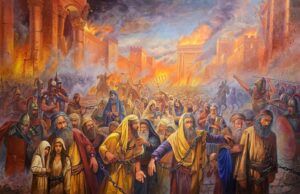
Jerusalem Temple Painting: Destruction of the Jerusalems Temple
$235 – $1,390 This product has multiple variants. The options may be chosen on the product page -

Jewish Painting: Light of Truth in the Darkness of the Persian Palace: Esther and King Ahasuerus
$195 – $1,160 This product has multiple variants. The options may be chosen on the product page -

Jewish Painting: Light in Dark times
$195 – $1,160 This product has multiple variants. The options may be chosen on the product page -

Jewish Painting: Legacy of Jewish Traditions
$195 – $1,220 This product has multiple variants. The options may be chosen on the product page -

Jewish Painting: Echo of the Shofar – The Voice of Prayer and Compassion
$195 – $1,220 This product has multiple variants. The options may be chosen on the product page -

Jewish Painting: Rachels Prayer for the Sons of Israel
$195 – $1,130 This product has multiple variants. The options may be chosen on the product page -

Jewish Painting: Israeli Valor – Standing in Fidelity
$195 – $1,220 This product has multiple variants. The options may be chosen on the product page -

Jewish Painting: Steel Defenders of Israel
$195 – $1,220 This product has multiple variants. The options may be chosen on the product page -

Jewish Painting: Reliability in the Sky – The Israeli Missile Shield
$195 – $1,220 This product has multiple variants. The options may be chosen on the product page -

Jewish Painting: Symbol of Israeli Resilience
$195 – $1,220 This product has multiple variants. The options may be chosen on the product page -

Jewish Painting: Moment of Struggle and Salvation
$195 – $1,220 This product has multiple variants. The options may be chosen on the product page -

Jewish Painting: Bullets and Blooms: Israel’s Story of Resistance
$195 – $1,220 This product has multiple variants. The options may be chosen on the product page -

Jewish Painting: Connection to the Heavens – Tefillin and Prayer
$195 – $1,220 This product has multiple variants. The options may be chosen on the product page -

Jewish Painting: Wisdom of the Endless Journey
$95 – $970 This product has multiple variants. The options may be chosen on the product page -
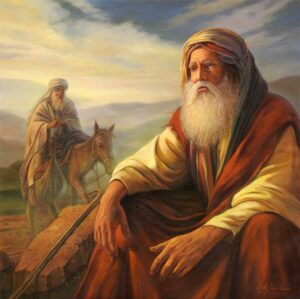
Jewish Painting: Sacred Reflections of Moses
$95 – $970 This product has multiple variants. The options may be chosen on the product page -

Jewish Painting: Abrahams Hospitality
$195 – $1,160 This product has multiple variants. The options may be chosen on the product page -
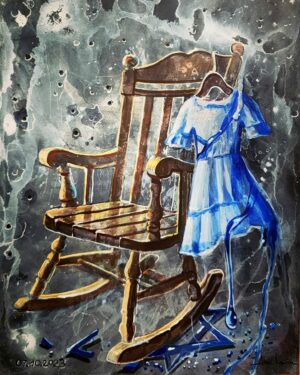
Jewish Painting: The Star of David in Flames
$195 – $1,130 This product has multiple variants. The options may be chosen on the product page -

Jewish Painting: Shema Israel on the Battlefield
$195 – $1,220 This product has multiple variants. The options may be chosen on the product page -

Jewish Painting: Generational Blessing
$195 – $1,220 This product has multiple variants. The options may be chosen on the product page -

Jewish Painting: Israeli Soldier, Heroism and Sorrow
$195 – $1,130 This product has multiple variants. The options may be chosen on the product page -

Jewish Painting: Prayer in the Darkness
$195 – $1,220 This product has multiple variants. The options may be chosen on the product page -

Jewish Painting: Symbols of Heroism and Eternal Memory of Israeli Soldiers
$195 – $1,130 This product has multiple variants. The options may be chosen on the product page -

Renaissance Surrealism Painting: Red Sea Marine Symphony
$195 – $545 This product has multiple variants. The options may be chosen on the product page -
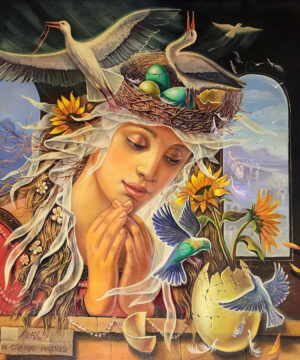
Renaissance Surrealism Painting: The Revival of Hope
$195 – $545 This product has multiple variants. The options may be chosen on the product page -

Abstract Jewish Painting: The Light of Jewish Faith
$275 – $1,110 This product has multiple variants. The options may be chosen on the product page -

Abstract Jewish Painting: The Energy of Faith – Mystical Tefillin
$195 – $1,130 This product has multiple variants. The options may be chosen on the product page -

Abstract Jewish Painting: Radiance of Prayer
$195 – $1,130 This product has multiple variants. The options may be chosen on the product page -

Abstract Jewish Painting: Harmony of Faith – Jerusalem Tapestry
$275 – $1,110 This product has multiple variants. The options may be chosen on the product page -

Abstract Jewish Painting: Tefillins triptych-sacred-bindings
$275 – $1,110 This product has multiple variants. The options may be chosen on the product page -

Jewish Painting: The Lubavitcher Rebbe – Rabbi Menachem Mendel Schneerson
$195 – $1,220 This product has multiple variants. The options may be chosen on the product page -
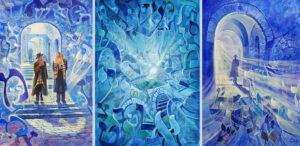
Abstract Jewish Painting: Kabbalistic Kaleidoscope of Tzfat
$275 – $1,110 This product has multiple variants. The options may be chosen on the product page -
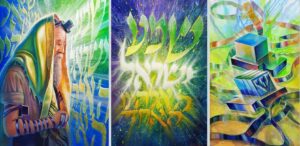
Abstract Jewish Painting: Celestial Harmony – Trifecta of Shema Yisrael
$275 – $1,110 This product has multiple variants. The options may be chosen on the product page -
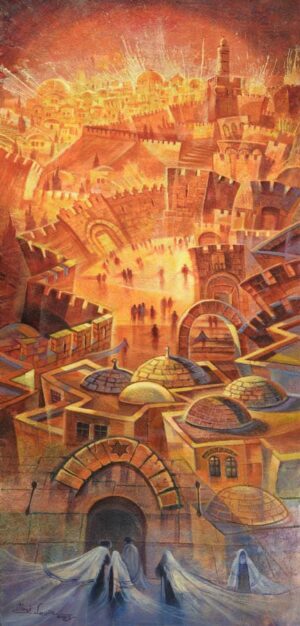
Abstract Jerusalem Painting: The Path of Light – David’s Tower in the Morning Prayer of Jerusalem
$275 – $1,740 This product has multiple variants. The options may be chosen on the product page -

Abstract Jerusalem Painting: Jerusalem’s Oratory of Light and Faith
$275 – $1,740 This product has multiple variants. The options may be chosen on the product page -

Jewish Painting: Shtetl of Narowlya Memories: Grandfather, Grandchildren, and a Rainy Day
$195 – $1,220 This product has multiple variants. The options may be chosen on the product page -

Abstract Jerusalem Painting: Jerusalem Elegy – Tablets of the Covenant and the Spirit of the Jews
$275 – $1,740 This product has multiple variants. The options may be chosen on the product page -

Abstract Jewish Painting: Rachel’s Prayer – Light and Hope for Israeli Soldiers
$235 – $1,220 This product has multiple variants. The options may be chosen on the product page -

Abstract Jerusalem Painting: Gateway to Our Roots – Ascending Home
$235 – $1,350 This product has multiple variants. The options may be chosen on the product page -
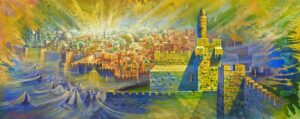
Abstract Jerusalem Painting: Journey through Time – Jerusalem’s Heartbeat
$275 – $1,740 This product has multiple variants. The options may be chosen on the product page -

Abstract Jewish Painting: Klezmer Musicians in the Shtetl
$195 – $1,350 This product has multiple variants. The options may be chosen on the product page -

Abstract Jewish Painting: Klezmer Melodies – Song of the Shtetl
$235 – $1,220 This product has multiple variants. The options may be chosen on the product page -

Painting: Azure Dreams, feminine beauty at the shores of Tel Aviv
$195 – $800 This product has multiple variants. The options may be chosen on the product page -

Surrealism Painting: Life begins with an egg
$195 – $915 This product has multiple variants. The options may be chosen on the product page -
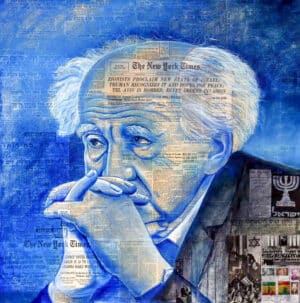
Israeli Painting: Zionists Proclaim State of Israel
$95 – $970 This product has multiple variants. The options may be chosen on the product page -

Abstract Jerusalem Painting: Radiance of the Holy Sepulchre
$95 – $970 This product has multiple variants. The options may be chosen on the product page -

Nature Painting: Sunset Encounter at Golan Heights with a View of the Sea of Galilee
$195 – $935 This product has multiple variants. The options may be chosen on the product page -

Nature Painting: Blooming Almond Trees under the Jerusalem Sky
$195 – $935 This product has multiple variants. The options may be chosen on the product page -

Jerusalem Painting: Family Journey to the Western Wall in Jerusalem
$195 – $1,220 This product has multiple variants. The options may be chosen on the product page -

Jerusalem Temple Painting: Ascending to the Temple Mount
$235 – $1,390 This product has multiple variants. The options may be chosen on the product page -

Surrealism Painting: Eternal Rebirth
$95 – $970 This product has multiple variants. The options may be chosen on the product page -

Surrealism Painting: Meditation of Time
$195 – $915 This product has multiple variants. The options may be chosen on the product page -

Jewish Painting: Tzfat – Safed
$195 – $915 This product has multiple variants. The options may be chosen on the product page -

Jewish Painting: Street of Tzfat – Safed
$195 – $915 This product has multiple variants. The options may be chosen on the product page -

Tel Aviv Painting: The Charm of Old Jaffa
$195 – $1,160 This product has multiple variants. The options may be chosen on the product page -

Tel Aviv Painting: At the Flea Market in Jaffa
$195 – $1,160 This product has multiple variants. The options may be chosen on the product page -

Abstract Jerusalem Painting: Jerusalem’s Radiance
$235 – $1,220 This product has multiple variants. The options may be chosen on the product page -

Abstract Jerusalem Painting: Golden Wall of Eternity
$275 – $1,740 This product has multiple variants. The options may be chosen on the product page -

Abstract Jerusalem Painting: Kotel – Golden Wall of Eternity
$95 – $970 This product has multiple variants. The options may be chosen on the product page -

Jerusalem Painting: Rebirth of Tiferet Yisrael Synagogue – A Symbol of Eternity and Hope
$195 – $1,390 This product has multiple variants. The options may be chosen on the product page -

Jewish Painting: Abraham – Path to the Promised Land
$195 – $1,220 This product has multiple variants. The options may be chosen on the product page -

Abstract Jerusalem Painting: The Light of the Torah and the Western Wall
$275 – $1,740 This product has multiple variants. The options may be chosen on the product page -

Abstract Jerusalem Painting: The Light of the Messiah over Jerusalem
$235 – $1,350 This product has multiple variants. The options may be chosen on the product page -

Abstract Jerusalem Painting: The Messiah’s Light over Jerusalem
$95 – $970 This product has multiple variants. The options may be chosen on the product page -

Abstract Jewish Painting: Lubavitcher Rebbe Energy of Light
$195 – $1,160 This product has multiple variants. The options may be chosen on the product page -

Jewish Monochnrome Painting: Lubavitcher Rebbe – Energy of Light
$195 – $1,130 This product has multiple variants. The options may be chosen on the product page -

Abstract Jewish Painting: Lubavitcher Rebbe – Sacred Brilliance
$195 – $1,160 This product has multiple variants. The options may be chosen on the product page -

Jewish Monochrome Painting: Lubavitcher Rebbe ? Sacred Brilliance
$195 – $1,130 This product has multiple variants. The options may be chosen on the product page -

Abstract Jewish Painting: The Lubavitcher Rebbe – A Figure of Light and Energy
$195 – $1,160 This product has multiple variants. The options may be chosen on the product page -

Abstract Jewish Painting: Colors of Wisdom – The Lubavitcher Rebbes Path of Faith
$195 – $1,160 This product has multiple variants. The options may be chosen on the product page -

Abstract Jewish Painting: The Lubavitcher Rebbe in Prayer – Light of the Torah
$195 – $1,160 This product has multiple variants. The options may be chosen on the product page -

Abstract Jewish Painting: Lubavitcher Rebbe – The Soul of Hasidism
$195 – $1,160 This product has multiple variants. The options may be chosen on the product page -

Jerusalem Painting: Golden Hour by the Kotel
$275 – $750 This product has multiple variants. The options may be chosen on the product page -

Abstract Jewish Painting: The Lubavitcher Rebbe in a Burst of Energy
$95 – $970 This product has multiple variants. The options may be chosen on the product page -

Nature Painting: Mosaic of peace – Jerusalem’s olive trees
$235 – $1,740 This product has multiple variants. The options may be chosen on the product page -

Nature Painting: Grapes of light on Jerusalem’s Hills
$235 – $1,740 This product has multiple variants. The options may be chosen on the product page -

Nature Painting: Mosaic of life pomegranates in Jerusalem
$235 – $1,740 This product has multiple variants. The options may be chosen on the product page -

Nature Painting: Grapes 7 species of Torah
$255 – $595 This product has multiple variants. The options may be chosen on the product page -

Nature Painting: Olives – 7 species of Torah
$255 – $595 This product has multiple variants. The options may be chosen on the product page -

Nature Painting: Figs – 7 species of Torah
$255 – $595 This product has multiple variants. The options may be chosen on the product page -

Nature Painting: Dates – 7 species of Torah
$255 – $595 This product has multiple variants. The options may be chosen on the product page -

Nature Painting: Wheat – 7 species of Torah
$255 – $595 This product has multiple variants. The options may be chosen on the product page -

Nature Painting: Pomegranates – 7 species of Torah
$255 – $595 This product has multiple variants. The options may be chosen on the product page -

Nature Painting: Sunlit Dates by the Dead Sea
$235 – $1,740 This product has multiple variants. The options may be chosen on the product page -

Nature Painting: Figs and Sunrays over the Sea of Galilee
$235 – $1,740 This product has multiple variants. The options may be chosen on the product page -

Nature Painting: Wheat Fields of the Golan Heights
$235 – $1,740 This product has multiple variants. The options may be chosen on the product page -

Abstract Jerusalem Painting: The Illumination of Jerusalem by the Torah Scroll
$275 – $1,740 This product has multiple variants. The options may be chosen on the product page -

Surrealism Painting: Shofar of Revelation – The Path to Light
$195 – $915 This product has multiple variants. The options may be chosen on the product page -

Abstract Jerusalem Painting: Divine Covenant – Kotel in the Light of the Torah
$275 – $1,740 This product has multiple variants. The options may be chosen on the product page -

Torah Portion Painting: Lech Lecha. Abraham?s Journey – Abraham walking through an ancient landscape
$95 – $970 This product has multiple variants. The options may be chosen on the product page -

Abstract Jerusalem Painting: The Shining Menorah over Jerusalem
$275 – $1,550 This product has multiple variants. The options may be chosen on the product page -

Torah Portion Painting: Vayera – The Laughter of Faith Abraham and Isaac
$95 – $970 This product has multiple variants. The options may be chosen on the product page -

Abstract Jerusalem Painting: The Light of Prayer at the Wall
$235 – $1,350 This product has multiple variants. The options may be chosen on the product page -

Abstract Jerusalem Painting: Light from the Kotel
$275 – $1,740 This product has multiple variants. The options may be chosen on the product page -

Abstract Jerusalem Painting: Light from Heaven over the Kotel
$95 – $970 This product has multiple variants. The options may be chosen on the product page -

Abstract Jerusalem Painting: Light of Faith at the Western Wall
$235 – $1,220 This product has multiple variants. The options may be chosen on the product page -

Abstract Jerusalem Painting: Golden Whispers of Jerusalem
$195 – $1,490 This product has multiple variants. The options may be chosen on the product page -

Abstract Jerusalem Painting: The Radiance of Jerusalems Ancient Walls
$275 – $1,740 This product has multiple variants. The options may be chosen on the product page -

Torah Portion Painting: Birkat Yitzchak – Isaac Blesses Jacob
$195 – $995 This product has multiple variants. The options may be chosen on the product page -

Abstract Jerusalem Painting: Golden Silhouettes of Jerusalem
$195 – $1,490 This product has multiple variants. The options may be chosen on the product page -

Abstract Jerusalem Painting: Eternal Jerusalem Light Through the Ages
$195 – $1,160 This product has multiple variants. The options may be chosen on the product page -

Torah Portion Painting: Parashat Vayeitzei – Jacob dreams of a ladder reaching from the earth to heaven
$195 – $995 This product has multiple variants. The options may be chosen on the product page -

Abstract Jerusalem Painting: The Golden Light of Jerusalem
$195 – $1,160 This product has multiple variants. The options may be chosen on the product page -

Jewish Surrealism Painting: Return to Zion
$95 – $970 This product has multiple variants. The options may be chosen on the product page -
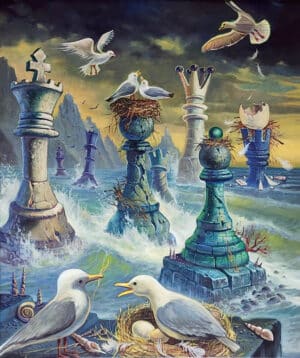
Surrealism Painting: Nests of Hope – The Return of the Jews to Israel
$195 – $915 This product has multiple variants. The options may be chosen on the product page -

Abstract Jerusalem Painting: Jerusalem – The Golden Stream of Prayers
$235 – $1,390 This product has multiple variants. The options may be chosen on the product page -

Abstract Jerusalem Painting: The Path of the Jews Through the Ages
$95 – $970 This product has multiple variants. The options may be chosen on the product page -

Nature Painting: Guardians of the Golan Heights
$275 – $845 This product has multiple variants. The options may be chosen on the product page -

Abstract Jerusalem Painting: Golden Aura of Jerusalem
$275 – $1,740 This product has multiple variants. The options may be chosen on the product page -

Abstract Jerusalem Painting: The Prayerful Light of Jerusalem
$195 – $1,160 This product has multiple variants. The options may be chosen on the product page -

Torah Portion Painting: Parashat Shemot – Moses Journey Begin
$95 – $970 This product has multiple variants. The options may be chosen on the product page -

Abstract Jewish Painting: Jewish Dance of Light
$95 – $970 This product has multiple variants. The options may be chosen on the product page -

Surrealism Painting: Flame of Love
$195 – $915 This product has multiple variants. The options may be chosen on the product page -

Torah Portion Painting: Parashat Shemot – Moses and the Burning Bush
$95 – $970 This product has multiple variants. The options may be chosen on the product page -

Jewish Painting: The Joy of Learning in Shtetl
$95 – $970 This product has multiple variants. The options may be chosen on the product page -
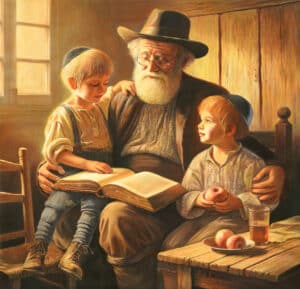
Jewish Painting: Shabbat Morning in the Shtetl
$95 – $970 This product has multiple variants. The options may be chosen on the product page -

Jewish Painting: A Song for My Grandchild
$95 – $970 This product has multiple variants. The options may be chosen on the product page -

Jewish Painting: Fixing Time with Grandfather
$95 – $970 This product has multiple variants. The options may be chosen on the product page -
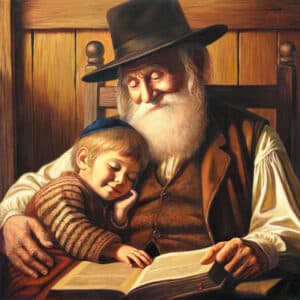
Jewish Painting: Shtetl Storytime
$95 – $970 This product has multiple variants. The options may be chosen on the product page -
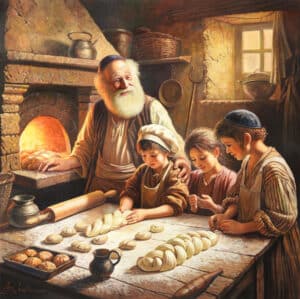
Jewish Painting: Making Challah with Zaide Before Shabbos
$95 – $970 This product has multiple variants. The options may be chosen on the product page -
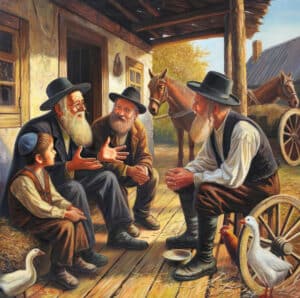
Jewish Painting: Tales on the Porch in the Shtetl
$95 – $970 This product has multiple variants. The options may be chosen on the product page -

Jewish Painting: Zaydes Little Builders
$95 – $970 This product has multiple variants. The options may be chosen on the product page -

Jewish Painting: The Clockmaker of the Shtetl – Teaching the Next Generation
$95 – $970 This product has multiple variants. The options may be chosen on the product page -

Jewish Painting: A Journey on Grandfather’s Shoulders in the Shtetl
$95 – $970 This product has multiple variants. The options may be chosen on the product page -

Jewish Painting: Under Grandfathers Wing
$95 – $970 This product has multiple variants. The options may be chosen on the product page -
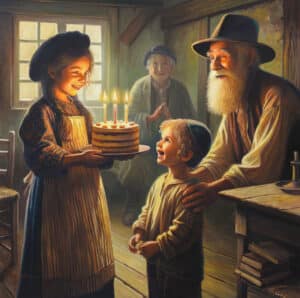
Jewish Painting: Birthday Celebration in the Shtetl
$95 – $970 This product has multiple variants. The options may be chosen on the product page -
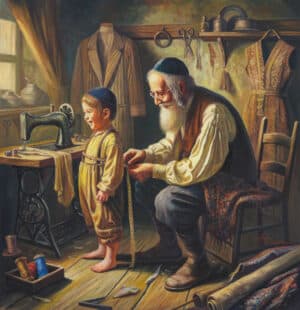
Jewish Painting: Tailor of the Shtetl
$95 – $970 This product has multiple variants. The options may be chosen on the product page -
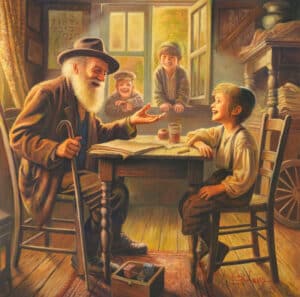
Jewish Painting: Laughter and Learning in Shtetl
$95 – $970 This product has multiple variants. The options may be chosen on the product page -

Jewish Painting: In Grandfathers Tailors Room
$95 – $970 This product has multiple variants. The options may be chosen on the product page -

Jewish Painting: Lessons in Grandfathers Carpentry Shop
$95 – $970 This product has multiple variants. The options may be chosen on the product page -
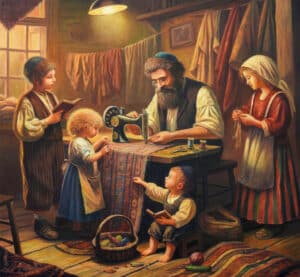
Jewish Painting: A Day in the Tailors House in the Shtetl
$95 – $970 This product has multiple variants. The options may be chosen on the product page -

Jewish Painting: Chernobyler Rebbe of Boro Park
$235 – $1,480 This product has multiple variants. The options may be chosen on the product page -

Nature Painting: When the Heavens Bless the Land of Israel
$195 – $935 This product has multiple variants. The options may be chosen on the product page -

Jerusalem Painting: Roots of Israel. The Path to Jerusalem
$195 – $1,160 This product has multiple variants. The options may be chosen on the product page
